airline deregulation
description: removal of government controls on airline industry
53 results

Why Airplanes Crash: Aviation Safety in a Changing World
by
Clinton V. Oster
,
John S. Strong
and
C. Kurt Zorn
Published 28 May 1992
The foundation upon which these conclusions are built begins in the next chapter with an examination of U.S. airline safety in an era of deregulation. I THE SAFETY RECORD This page intentionally left blank Chapter 2 The U.S. Airline Safety Record in the Post-Deregulation Era The U.S. airline industry has changed dramatically since passage of the Airline Deregulation Act in 1978. Flexibility in route entry and exit and in fare setting stimulated competition, encouraged new entrants, and forced all airlines to pay more attention to cost control, productivity improvements, and marketing. These changes, while generally beneficial for consumers,1 have raised questions and concern about safety.
…
While the early post-deregulation years were characterized by rapid industry growth and the creation of many new airlines, the years following 1986 have been characterized by industry consolidation and serious financial problems among several large carriers. Even though safety regulation was not directly affected by the Airline Deregulation Act of 19782 some participants and observers of the industry fear that there has been an unintended negative impact. 'John R. Meyer and Clinton V. Oster, Jr., Deregulation and the Future of Intercity Passenger Travel (Cambridge: The MIT Press, 1987), pp. 83-107. 2 Commuter safety regulations were tightened in 1978, the same year the Deregulation Act was passed, but these safety changes had been in the works for several years and it was coincidental that both happened the same year. 19 20 WHY AIRPLANES CRASH: AVIATION SAFETY IN A CHANGING WORLD DEREGULATION'S POTENTIAL IMPACTS ON SAFETY Many who are concerned about deregulation's potentially adverse impact on safety contend that fare competition has weakened the financial status of many carriers, forcing them to reduce expenditures in critically important areas.
…
Block A symbol appearing on an air traffic control display that provides information concerning an aircraft, its speed, location, and direction. Buzz Flying at very low altitude over a particular target or location. Civil Aeronautics Board (CAB) The U.S. agency that had jurisdiction over the development, regulation, and control of civil air carriers. The CAB went out of existence in 1984 as a direct result of the Airline Deregulation Act of 1978. Callout The practice of verbal communication of operating procedures or checklists, generally done in the cockpit prior to departure; also, the practice of repeating air traffic control instructions. Canadian Air Safety Board (CASB) Canadian agency responsible for accident investigation and safety recommendations; similar to the National Transportation Safety Board (NTSB) in the United States.
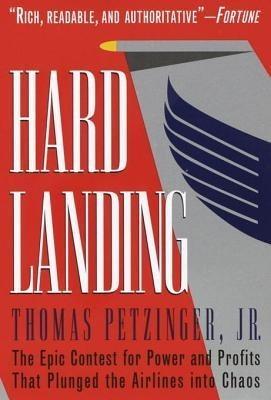
Hard Landing
by
Thomas Petzinger
and
Thomas Petzinger Jr.
Published 1 Jan 1995
Kennedy, who was nothing if not gracious when the situation demanded, immediately called attention to the significance of this day. “Mr. President, I want you to meet Phil Bakes,” Kennedy said. “He and Mary Schuman are the people responsible for this.” Carter’s lips grew tighter as the group exited. But by the time he signed the Airline Deregulation Act of 1978, Carter was beaming with pride. Flanking him were Kennedy and Cannon, Monte Lazarus from United, Alfred Kahn, and even the former CAB chief, John Robson. “For the first time in decades,” Carter said, “we have deregulated a major industry.” A mile to the north, as Carter spoke, a line had already begun forming outside CAB headquarters.
…
“hardest to destroy”: From “Essay on Bureaucracy,” by Max Weber, in Rourke, Bureaucratic Power in National Politics, page 58. 45. only sensible course: Robson 1/7/93 interview. 46. furiously lobbied: Cohen 2/16/93 interview. 47. writing a dissent: Ibid. 48. visibly startled: Brown, The Politics of Airline Deregulation, page 113. 49. “mesmerized by computer models”: U.S. Senate, Hearings Before the Subcommittee on Aviation, Apr. 1, 1977. 50. “fucking academic eggheads”: Bakes 5/11/93 interview. Crandall does not recall the comment but does not deny making it. 51. In contemplating candidates: Ibid. 52. “free-fire zone”: “CAB Proposes 50% Fare Cut Zone,” Aviation Week, Apr. 10, 1978. 53. “get big quick”: Ferris 5/28/93 interview. 54. death of the senior senator: “Washington Update,” National Journal, Dec. 3, 1977. 55.
…
Within a month of her appointment, Schuman and a few associates wrote a paper for Carter on airline deregulation. Airlines, the paper said, were “naturally competitive.” Regulation was “inappropriate.” The policies of the CAB had brought about “inflated fares” and “half-empty planes.” Airlines were “heading the way of the railroads,” the memo said. Ted Kennedy, looming as a potential Carter rival in the next presidential election, was out in front on the issue. There were five bills for airline deregulation already pending in Congress, Schuman told the president. But Carter, the memo added, might be able to turn all the action in Congress to his own political advantage.
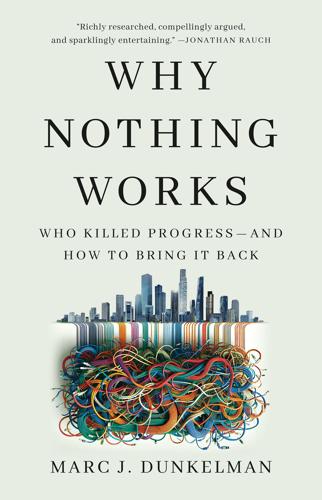
Why Nothing Works: Who Killed Progress--And How to Bring It Back
by
Marc J Dunkelman
Published 17 Feb 2025
And so the broader infrastructure of airline regulation was, in successive waves, demolished. Kahn used his authority as chairman to approve routes that previous CAB chairmen had rejected. And Kennedy helped to usher in the Airline Deregulation Act of 1978, which Carter signed triumphantly. With that, Washington edged its way (mostly) out of the marketplace.9 In the decades that followed, progressives would quietly debate among themselves whether airline deregulation worked—whether, in fact, the public would have been better served by reforming rather than eviscerating the CAB. Over time, as upstart competitors began to serve the routes the legacy carriers had once dominated and unionized employee benefits were pared down to be much less generous, some began to wax poetic for the old regime.
…
Eizenstat, President Carter, 359–360. Reuel Schiller, “The Curious Origins of Airline Deregulation: Economic Deregulation and the American Left,” Business History Review 93 (Winter 2019). 4. Levine, “Why Weren’t the Airlines Reregulated?,” 276. 5. Eizenstat, President Carter, 358–360. 6. Schiller, “The Curious Origins of Airline Deregulation.” Thomas K. McCraw, Prophets of Regulation (Cambridge, MA: Belknap, 1986). 7. Martha Derthick and Paul J. Quirk, The Politics of Deregulation (Washington, DC: Brookings, 1985), 39–53. Schiller, “The Curious Origins of Airline Deregulation.” 8. McCraw, Prophets of Regulation, 265–270. 9.
…
McCraw, Prophets of Regulation, 265–270. 9. Derthick and Quirk, The Politics of Deregulation, 5. Schiller, “The Curious Origins of Airline Deregulation.” 10. “United Airlines Receives Court Approval to Terminate Workers’ Pension Plans,” PBSNews Hour, May 11, 2005, www.pbs.org/newshour/show/united-airlines-receives-court-approval -to-terminate-workers-pension-plans. 11. United States Government Accountability Office, “Airline Deregulation: Reregulating the Airline Industry Would Likely Reverse Consumer Benefits and Not Save Airline Pensions,” June 2006, www.gao.gov/assets/gao-06-630.pdf. 12. Debbie Aiken, “Remembering FDR’s Commencement Address at Oglethorpe,”Source, May 22, 2012, https://source.oglethorpe.edu/2012/05/22/remembering-fdrs-commencement-speech-at-oglethorpe/. 13.
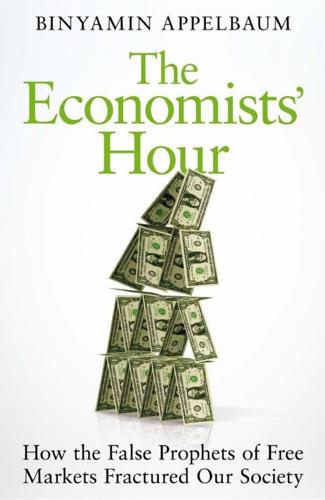
The Economists' Hour: How the False Prophets of Free Markets Fractured Our Society
by
Binyamin Appelbaum
Published 4 Sep 2019
David Hummels, “Transportation Costs and International Trade in the Second Era of Globalization,” Journal of Economic Perspectives 21, no. 3 (2007): 131–54. 58. Penelope Overton, “Asians Help to Fill Sales Gap as Europe Eats Less Maine Lobster,” Portland [Maine] Press Herald, February 16, 2018. 59. Richard E. Cohen, “The CAB’s Kahn on Aggravations of Airline Deregulation,” National Journal, January 14, 1978, 50. In November 1978, Newsweek ran a profile of Kahn, who was then leaving the aviation board, in which it quoted him as saying, when he arrived on the job the previous year, “I will consider it some measure of success in this job if there is no job when I leave it.” But there is no earlier record of the comment, and Kahn insisted in later years that he arrived with an open mind.
…
One staffer described it as a “fire brigade for liberal causes,” forever arriving with lights and sirens at the scene of the latest outrage against the common man.29 In 1974, Kennedy lured Stephen Breyer, then a rising star at Harvard Law School, to spend a sabbatical year in Washington. Breyer proposed a pair of possible investigations. The first, on post-Watergate reforms, Breyer described as “more likely to receive publicity.” The second, airline deregulation, he described as “a non-glamorous, detailed, intricate, ‘good government’ job.”30 Kennedy chose deregulation. When the committee held a hearing in Boston a few months later, a local woman asked the senator, “Why are you having hearings on airlines? I’ve never been able to fly.” Kennedy replied, “That’s why I’m having the hearings.”31 Soon after starting his new job, Breyer read in the Washington Post that President Ford’s transportation secretary, Claude Brinegar, was meeting with airline executives to discuss the plight of Pan American Airways, which was struggling with rising fuel prices.
…
They advised Carter to start with airlines instead.39 The glamorous industry commanded public attention, but it was not particularly large, and Kennedy’s hearings had primed the public. Simon Lazarus, who had known Breyer since law school and received a personal copy of his report, and Mary Schuman, a former staffer on the Senate Commerce Committee, told Carter that airline deregulation could serve as a springboard for battles over trucks and telecommunications. In February 1977 — on the same day the first supply-side tax cut bill was introduced in the House — the White House launched a push to deregulate commercial aviation. Seizing on a new government report that estimated airline regulation was inflating ticket costs by $1.8 billion a year, Carter sent a message to Congress urging legislation to set the industry free.40 “Regulation, once designed to serve the interests of the public, now stifles competition,” the President wrote.
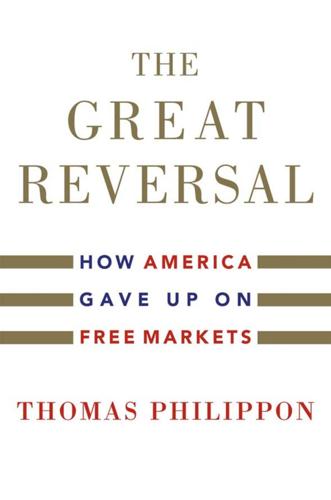
The Great Reversal: How America Gave Up on Free Markets
by
Thomas Philippon
Published 29 Oct 2019
None of this happened by chance, although I was blissfully unaware of it at the time. The Land of Free Markets Let us consider air transport first. Before 1978, the Civil Aeronautics Board regulated airlines in the US, controlling the fares they could charge and the routes they could fly. The Carter Administration argued that customers would benefit from deregulation because it would encourage competition among existing carriers as well as entry of new airlines. And it did. The Airline Deregulation Act of 1978 phased out the government’s control over prices and routes. Over the following fifteen years, from 1979 to 1994, the average fare per passenger mile decreased by about 9 percent at airports in small communities, 11 percent at airports in medium-sized communities, and 8 percent at airports in large communities, as documented by the Government Accountability Office in its 1996 report.
…
Although the Lisbon Strategy failed in some dimensions, substantial product market reforms were implemented. European economies have some of the lowest barriers to trade and foreign investment in the world. Let us look at a few examples before we give a full account. Airlines The US began liberalizing air travel in 1978 when Congress passed the Airline Deregulation Act. By the 1990s, US skies were competitive. Figure 8.3 shows the evolution of concentration and profits in air transportation over the past two decades in the US and in Europe. Concentration was stable in the US during the 1990s and until 2008. Profits were highly cyclical and volatile.
…
I am grateful to Ian Malcolm and Mark Steinmeyer, who saw promise in my early ideas, to Rob Garver and Katherine Brick, who edited my dry and technical prose, to the team at Harvard University Press for their professionalism, and to the Smith Richardson Foundation for its support. Abhishek Bhardwaj and Matias Covarrubias provided invaluable assistance and feedback. INDEX Acemoglu, Daron, 58 adaptation, 287 Adelson, Sheldon, 174 Adelstein, Jonathan, 200 Adenauer, Konrad, 131, 132, 142 age, of successful entrepreneurs, 82 Air France, 139 Airline Deregulation Act (1978), 2, 137 air transport and airline industry: deregulation of, 2–3, 30–31, 137–140; costs in US versus Europe, 7; HHI in, 35–37, 39; and concentration of health care, 231 Alesina, Alberto, 125 Alpert, Abby, 235–236 Al-Ubaydli, O., 95 aluminum tariffs, 160–161 Amazon: growth of, 39–44; profit margin of, 43; state aid for, 135; business model of, 244, 285; MV / Emp ratio of, 255; lobbying by, 260, 261.

Skygods: The Fall of Pan Am
by
Robert Gandt
Published 1 Mar 1995
“The airline was on its deathbed,” said Bob Garrett, Lorenzo’s financial adviser. “Yet Frank managed to pull all the various sides together. He kept working and working after everyone else had stopped.” This was all before deregulation. Then came 1978, the year of the Airline Deregulation Act. It was a unique moment in airline history— a time just made for someone like Frank Lorenzo. Who the hell is Frank Lorenzo? That was what they wanted know at National’s Miami headquarters on July 9, 1978, the day Lorenzo informed the CAB that he had bought 9 percent of National Airlines’ stock. He had also informed the board that he, by the way, intended to buy up to 15 percent, or as much as it took to have controlling interest.
…
“Pan Am can go to hell,” he snapped to the press one day after he’d heard enough about Pan Am’s problems. Later, when he’d had time to cool down, Kahn thought about what he’d said. Actually, he told a reporter, for Pan Am “that would be an interesting new route.” In the fall of 1978, the rules changed. The long-simmering Airline Deregulation Act was finally signed into law. What it meant, in effect, was that anyone could fly anywhere, at least within the United States. Deregulation was a trendy idea whose time had come during the inflation-ravaged 1970s. The traveling public— and its elected congressmen—were fed up with runaway airline fares and the inability of the bureaucratic CAB to regulate anything.
…
And then, three hours before the proxy material was supposed to go out to the stockholders, another player jumped into the game: astronaut Frank Borman, down from outer space and now the chairman of Eastern, was offering $50 a share. The game was on again. Regardless of who made the most outrageous offer for National Airlines, any such merger still required the approval of aviation’s most plodding bureaucratic agency. Even though the Airline Deregulation Act of 1978 imposed a death sentence on the Civil Aeronautics Board, the CAB was still around in the summer of 1979. The five-member board would have to study the matter and make its recommendation. The President, Jimmy Carter, would render a final decision. While the CAB deliberated—the CAB always deliberated—the fight for National became a prime topic for the business press.
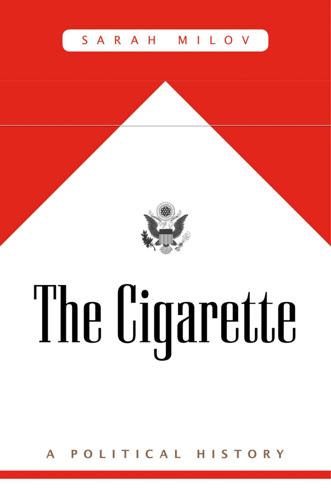
The Cigarette: A Political History
by
Sarah Milov
Published 1 Oct 2019
These new Democrats changed the priorities of their party, making it less economically populist but more liberal on social issues like civil and sexual rights, the environment, and consumer protection. Among this new cohort, the old, competition-stifling, giant-protecting CAB had few friends. The Airline Deregulation Act of 1978 passed easily in both chambers. The CAB became the poster child for deregulation. It was an agency in which the corporatist DNA of the National Recovery Act was still visible in its alignment of “the public interest with the desires of the most powerful elements” of industry.49 Ushering the agency out of existence was Alfred Kahn, the chair of the CAB.
…
The Carter appointee and Cornell economist called himself a liberal Democrat, and it took some persuading by the President for Kahn to embrace his role as a deregulatory pioneer.50 Before his appointment to the agency in 1977, Kahn sat at the helm of the powerful New York State Regulatory Commission, an experience that validated his academic observations about the tradeoffs between regulation and competition, between market stability and consumer price. Dubbed “The Father of Airline Deregulation,” Kahn embraced a theory of marginal costs: that in the absence of price-distorting regulation, competition would cause prices to fall, opening the skies to more Americans. Airline deregulation became a general model for federal retrenchment from the trucking, bus transportation, railroads, telecommunications, oil, and finance sectors.51 In its lame duck years, the CAB relaxed some smoking rules as part of a commitment to “permit experimentation and encourage innovation by the airlines.”52 Airlines were much happier to advertise their new nonsmoking sections than they were to police disgruntled passengers.
…
And as such, it was embraced by Democratic and Republican politicians alike. Talk of loosening the strictures on regulated industries began well before the Reagan Revolution’s full-throated denunciation of government. Initiated under a Democratic Congress, and shepherded by liberal lion Ted Kennedy, airline deregulation formed a centerpiece of Jimmy Carter’s efforts to deregulate the transportation industry “as much as possible.”48 The Democratic “Watergate babies” elected in the wake of Nixon’s resignation were less credulous of federal regulatory initiatives than senior colleagues who had come of age during the Depression.
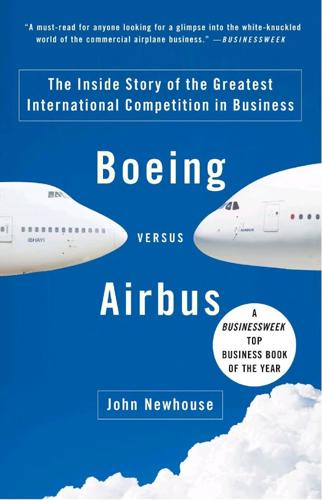
Boeing Versus Airbus: The Inside Story of the Greatest International Competition in Business
by
John Newhouse
Published 16 Jan 2007
Boeing estimates that air travel worldwide has tripled since 1980. Boeing and Airbus are both forecasting 5 percent annual growth in airline travel over the next twenty years.1 The woes of America’s airlines were largely self-inflicted, decades in the making, and are worsening. Much of what has gone wrong can be traced to 1978, when the Airline Deregulation Act was adopted. It liberated the airlines by allowing them, instead of a government agency, to decide which routes they could fly and at what cost to the passenger. Government supervision of what had been judged a public utility gave way to free market economics. Predictably, the industry’s irrational tendencies took over, and it quickly outgrew itself.
…
By the late 1980s, the legacy carriers—the half-dozen major carriers that have been around longer than most of the others and operate both nationally and internationally—had embarked on a feeding frenzy, adding new airplanes to their fleets without retiring older ones. (These are hardy, long-lived vehicles.) Credit wasn’t a problem—there was a great deal of money chasing airplanes; airlines were borrowing 120 percent of the net purchase of their new aircraft. And they were busily expanding their hub airports. Airline deregulation, a useful step in principle, was never about building a strong industry; it was about lowering ticket prices by creating competition. And it did give rise to a commodity marketplace, hence competition. But most airlines either didn’t favor deregulation or, like Delta Airlines, openly opposed it.
…
Things would be on hold. And lots of questions were asked about why we were doing what we were doing instead of having us just doing it. Things got proceduralized.”13 Some operations became more proceduralized, probably because they had to be. Schrontz and Thornton had to start coping with the effects of airline deregulation that were beginning to take hold. The regulated environment had been easier on all parties, except for the air traveler. An airframe maker knew that a portion of his costs could be passed on to the airline, which in turn could pass on its higher costs to the passenger, provided the Civil Aeronautics Board approved the increase in price of a given fare.
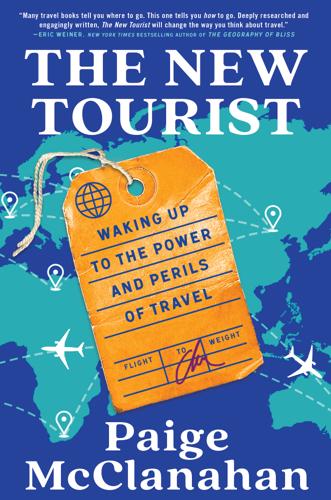
The New Tourist: Waking Up to the Power and Perils of Travel
by
Paige McClanahan
Published 17 Jun 2024
Kennedy Presidential Library & Museum, https://www.jfklibrary.org/archives/other-resources/john-f-kennedy-speeches/peace-corps-establishment-19610301. 8 Sara Wheeler, “The World with Its Trousers Down,” Guardian, September 13, 2008. 9 Martha Gellhorn, Travels with Myself and Another: A Memoir (London: Allen Lane, 1978), 293. 10 This and other quotes are from Tony Wheeler, Across Asia on the Cheap (Sydney: Lonely Planet, 1973). 11 These and other quotes are from Wheeler and Wheeler, Unlikely Destinations, 39–40. 12 Ibid., 43. 13 Rolf Potts, “Travel Writer: Bill Dalton,” Ralf Potts, February 1, 2003, https://rolfpotts.com/bill-dalton/. 14 Hilary Bradt, author Zoom interview, March 2022. 15 Mark Ellingham, author Zoom interview, March 2022. 16 “ ’Notable Alumni,” Let’s Go, https://www.letsgo.com/alumni. 17 Serena Jampel, “Let’s Go: Gone at 63,” Harvard Crimson, April 13, 2023, https://www.thecrimson.com/article/2023/4/13/lets-go-travel-guide/. 18 Rick Steves, author Zoom interview, February 2023. 19 “Airline Deregulation: When Everything Changed,” National Air and Space Museum, December 17, 2021, https://airandspace.si.edu/stories/editorial/airline-deregulation-when-everything-changed. 20 Joe Cummings, author Zoom interview, May 2022; see also Joe Cummings, “Plenty of Whiskey, Few Backpackers: The Wild Story behind Lonely Planet’s First Thailand Guidebook,” CNN Travel, updated April 23, 2020, https://edition.cnn.com/travel/article/joe-cummings-lonely-planet-thailand/index.html. 21 Pico Iyer, “The Smiling Lures of Thailand,” Time, October 17, 1988, https://time.com/vault/issue/1988-10-17/spread/90/. 22 Sports Illustrated 68, no. 7 (February 2, 2015), https://archive.org/details/sports-illustrated-1988-02-15-swimsuit-issue-b/mode/2up. 23 The 1960 figure is from James Elliott, “Government Management of Tourism—A Thai Case Study,” Tourism Management 8, no. 3 (September 1987): 223–32.
…
For a comprehensive list of locations of any word or phrase, use your reading system’s search function. Abu Dhabi, falcon hospital in, 188, 190, 198 Across Asia on the Cheap (Wheeler), 10–12 Afghanistan, 3, 9 Africa, 7, 200 Aiguille du Midi, 131 Airbnb, 43, 106, 122–24, 179, 181 Air Force, U.S., 146 Air Transportation Systems Laboratory, 144 air travel airline deregulation and, 15 climate impact of, 140–48 contrails and, 147 electric aircraft in, 143, 146–47 hydrogen-powered aircraft in, 143, 146 international, growth of, 9, 15, 17, 18, 33 net-zero carbon emissions goal and, 143, 146, 147 power-to-liquid fuel in, 145–46 sustainable aviation fuel in, 143–46 volcano eruption and, 58 Albert Dock, 74–75 Aletsch Glacier, 134 Al-Fayez, Nayef, 60 Ali, Rafat, 32 Al Jazeera, 84 Al Masmak Fortress, 207–8 Alps, xiii, 3, 110, 129, 134, 137 Al Zimam, Fatimah, 191, 193–96, 207–8 American Psychological Association, 168 Amsterdam, 145, 162, 177, 178, 187 drugs in, 158, 181, 182 Halsema as mayor of, 181–82, 186 I amsterdam campaign in, 178–80, 182 parade in, 183–84 Red Light District in, 157–62, 167–68, 174, 177–86 reputation of, 178 tourist pledges in, 185 tourist-reduction campaign in, 168, 179–82 amsterdam&partners, 162 Anderson, Joe, 78 Angkor Wat, 37–41, 46, 47, 62–63, 65, 66 Antarctic, 137, 139 Arab Spring, 60 Arctic, 137 Argentina, 134 Asia, 6–8, 10–12 Hippie Trail across, 2, 7, 9, 10 Wheelers’ trip across, 1–2 Aspen, CO, 185 Associated Press, 84, 85 Athens, 124 Atlantic, 30 Aulani Resort, 90 Australia, 2–4, 135 Austria, 137 Aymanam, 108–12 baby boomers, xx, 1–2, 4, 6, 9, 13, 15, 33 Backlinko, 47 backpackers, 12, 14, 15, 19, 21, 22, 24, 25, 31, 103, 105 Backpacking Along Ancient Ways in Peru and Bolivia (Bradt and Bradt), 12 Baedeker Guides, 4, 23 Bahrain, 192 Barcelona, 79, 99–108, 122–26, 177, 188 anti-tourism protests in, 101 caganers in, 102–4 Colau as mayor of, 122–23, 126 industrial economy of, 99–100 La Rambla in, 105–6 Olympics hosted by, 99–100, 126 Sagrada Família in, 104 Sant Antoni neighborhood of, 103, 106 tourist rentals in, 122–24 Turisme de Barcelona in, 100 Barrett, Steven, 144, 145, 147 Bassetti, Jeremy, 46 BBC, 75, 136 Lonely Planet acquired by, 30, 32–33 Beach, The (film), 25 Beach, The (Garland), 24–25 beach resorts, 199 Beatles, 8, 71, 74, 75 Becker, Elizabeth, 70 Beckford, Gabby, 50–51, 61 Bend, OR, 186 Berlin, 124 Best American Travel Writing, The (Wilson, ed.), 46 Beyoncé, 75 Bieber, Justin, 55–57, 62, 63, 65, 82, 176 Big Ben, 64 BIT, 6–7 Bjarnason, Egill, 84–85 Black Travel Alliance, 51 blogs, 60–62 Bloom Consulting, 87 Blue Guides, 4 boarding passes, 67–68 Bolivia, 134–35 Bonaparte, Napoleon, 130 Booking.com, 43 Bookings.nl, 43 Bradt, George, 12–13, 34 Bradt, Hilary, 12–13, 33–35 Bradt Travel Guides, 12–13, 34–35 Brady Bunch, The, 113–14 Brévent, 131 Bruinsma, Geert-Jan, 43 Burj Khalifa, 167 Bush, George H.
…
Paul Theroux’s travelogue The Great Railway Bazaar, which describes his travels along the Hippie Trail to India and beyond, became an international bestseller after it was published in 1975, adding ever more fuel to the fire.8 By the time the Iranian Revolution and the Soviet invasion of Afghanistan brought the Hippie Trail to an abrupt end in 1979, tens of thousands of young travelers had made the trek. But even with the closure of the Hippie Trail, by the dawn of the 1980s it was clear that, for a growing number of people, the world was shrinking very quickly indeed. In her travel memoir published in 1978, the journalist and author Martha Gellhorn observed that “perhaps the greatest social change since the Second World War is the way citizens of the free nations travel as never before in history.” Gellhorn described the new class of global wanderers as both “a vast floating population and an industry” that was “essential to many national economies.”
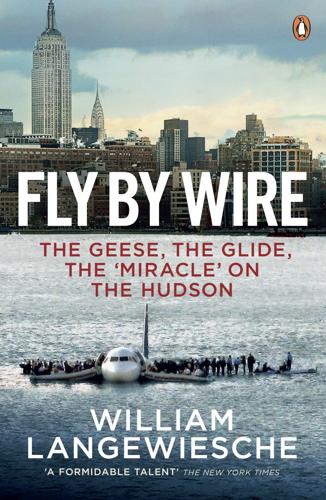
Fly by Wire: The Geese, the Glide, the Miracle on the Hudson
by
William Langewiesche
Published 10 Nov 2009
But safety aside, no pilot of whatever mental capacity enters the profession expecting to see his income cut, particularly when airline executives continue to increase their own compensation, as they have. This is what Sullenberger was legitimately complaining about to Congress. Ever since airline deregulation in the United States in 1978, which did away with route monopolies and noncompetitive pricing, and especially since the terrorist attacks of September 2001, which had all sorts of profound effects on the industry, most major American airlines have been miserable places to work. Two days after the Hudson River landing, accident investigators interviewed the pilots in New York’s Marriott Downtown hotel, near the site of the former World Trade Center.
…
But the real veteran of the crew was Doreen Welsh, now fifty-eight, who had joined US Airways when it was called Allegheny and she was twenty years old, in the dim and distant past of 1970. For reference, in 1970 Richard Nixon was in his first term in office, the war in Vietnam was raging, U.S. forces invaded Cambodia, protesters were shot dead in Ohio at Kent State University, Jimi Hendrix died young, and Barack Obama was nine years old. Furthermore, airline deregulation was still eight years ahead. However understandable Sullenberger’s laments may be about the loss of flight crews’ income, it must be said that he—like Skiles, Dent, and Dail—joined the airlines after the deregulation of the industry, when it was obvious that the unions would eventually be undermined by market forces, and that the unnaturally high salaries at the time simply could not be sustained.
…
Lockheed had just abandoned the commercial aircraft business, McDonnell Douglas was struggling to get by, and Boeing was the dominant manufacturer worldwide, with little incentive to rethink airplanes and retool its factories based on a still-immature technology. Furthermore, Boeing’s constituents among airline pilots were very clear in their disdain. The pilots were having a tough enough time already. Between the turmoil caused by airline deregulation and the coming of automation, which was reducing crew sizes from three to two, the glamour of airline jobs was visibly fading, and the profession was becoming less fun, less prestigious, and less well paid with every passing year. This was the start of the trend that Sullenberger complained about to Congress after his water landing twenty-four years later.
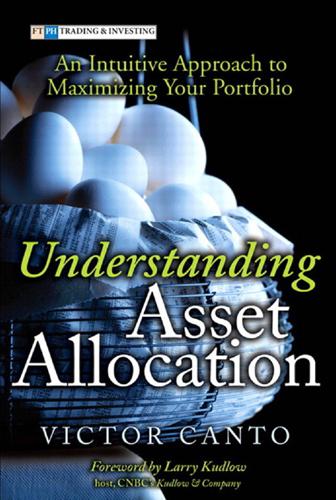
Understanding Asset Allocation: An Intuitive Approach to Maximizing Your Portfolio
by
Victor A. Canto
Published 2 Jan 2005
Generally, forecasting changes in the level of economic activity or economic conditions to predict aggregate demand is critically important to the cyclical investor. A close look at the airline industry’s experience demonstrates this point. 208 Supply Curve P1 Price Changes P0 Shift in Demand Quantity Q Figure 11.1 Inelastic industry: price changes in response to a shift in demand. Deregulation, as per the U.S. Airline Deregulation Act of 1978, changed the shape of the airline industry’s supply curve. New carriers’ entry almost instantly increased competition and industry prices became more elastic. Demand, in short, was largely met with the new airlines’ arrival. Once a scheduled flight was operational, independent of which airline was flying it, empty seats drove the market.
…
See elasticity survivor bias, 228 swing assets, 290n systematic risk, 3, 19-20, 113 T T-bills fixed-income cycles, 48-52 performance of, 16-17, 42 T-bonds CEM (capitalized earnings model) and, 90-94 fixed-income cycles, 48-52 optimal mix with equity stocks, 25-26, 37-39, 119 performance of, 16-18, 42-43 tax-rate changes and, 73 tactical asset allocation (TAA), xx, 18, 60, 101, 254 target return, 257 tax increase, equivalence to supply shift, 217-218 tax rates CEM (capitalized earnings model) modifications and, 95-96 elasticity and, 211 inflation and, 88-90 location effect and, 202 314 monetary policy and, 88-90 style cycles and, 56 Tax Reform Act of 1986, 73, 211 tax-rate changes, corporate behavior and, 68-70 capital gains, 76-79 debt financing, 73-76 incentive structure effects, 70-73, 80-84 taxes, elasticity and, 187-189 terrorism, stock market performance and, 202 top-performing asset classes, selecting, 8-11 Treasury bills. See T-bills Treasury bonds. See T-bonds 12 percent T-bill, 230 U-V U.S. Airline Deregulation Act of 1978, 209 valuation. See market valuation value stocks, 5 annual returns, 19 growth stocks versus, 272-273 optimal mix with growth stocks, 22-23, 26-30, 121 performance of, 16-17, 42 risk measurement, 20 style cycles, 55-57 tax-rate changes and, 75 value-timing asset allocation, 137-142 value-timing strategy cyclical asset allocation (CAA) as, 243-250 market-timing strategy versus, 276-277 variance, Sharpe ratio, 2 variance–covariance matrix, 21, 46 volatility, 2-3.
…
.* UNDERSTANDING ASSET ALLOCATION Equity versus Bonds Rank 1 2 1 2 1975 1976 1977 1978 1979 1980 1981 1982 1983 1984 1985 1986 1987 1988 1989 L 37.2 B 9.2 L 23.8 B 16.8 B –0.7 L –7.2 L 6.6 B –1.2 L 18.4 B –1.2 L 32.4 B 4 B 1.9 L –4.9 B 40.4 L 21.4 L 22.5 B 0.7 B 15.4 L 6.3 L 32.2 B 31 B 24.4 L 18.5 L 5.2 B –2.7 L 16.8 B 9.7 L 31.5 B 18.1 1990 1991 1992 1993 1994 1995 1996 1997 1998 1999 2000 2001 2002 2003 2004 B 6.2 L –3.2 L 30.6 B 19.3 B 8.1 L 7.7 B 18.2 L 10 L 1.3 B –7.8 L 37.4 B 31.7 L 23.1 B –0.9 L 33.4 B 15.9 L 28.6 B 13.1 L 21 B –9 B 21.3 L –9.9 B 6.9 L –13.1 B 14.1 L –23.7 L 28.7 B 1.3 L 10.7 B 9.3 1978 1980 1981 1982 1983 1984 Domestic versus International 1 2 1975 1976 1977 L 37.2 ROW 26.9 L 23.8 ROW –0.6 ROW 12.6 L –7.2 ROW 27.6 L 6.6 1992 1979 1985 1986 1987 1988 L 32.4 ROW 19.8 L –4.9 ROW –6.5 L 21.4 ROW –4.2 L 22.5 ROW 21 L 6.3 ROW 0.6 ROW 47.7 L 32.2 ROW 62.7 L 18.5 ROW 22.8 L 5.2 ROW 25.8 L 16.8 1993 1994 1995 1996 1997 1998 1999 2000 2001 2002 2003 2004 ROW 30.1 L 10 ROW 5.8 L 1.3 L 37.4 ROW 9.6 L 23.1 ROW 5.2 L 33.4 ROW 0.7 L 28.6 ROW 17 ROW 26.2 L 21 L –9.9 ROW –14.4 L –13.1 ROW –22.6 ROW –17.4 L –23.7 ROW 36.2 L 28.7 ROW 17.8 L 10.7 L 18.4 ROW 6.3 1989 1990 1991 1 L 31.5 L –3.2 2 ROW 9.8 ROW –24.4 L 30.6 ROW 10.1 L 7.7 ROW –14 1975 1976 1977 1978 1979 1980 1981 1982 1983 1984 1985 1986 1987 1988 1989 1990 S 52.8 L 37.2 S 57.4 L 23.8 S 25.4 L –7.2 S 23.5 L 6.6 S 43.5 L 18.4 S 39.9 L 32.4 S 13.9 L –4.9 S 28 L 21.4 S 39.7 L 22.5 L 6.3 S –6.7 L 32.2 S 24.7 L 18.5 S 6.9 L 5.2 S –9.3 S 22.9 L 16.8 L 31.5 S 10.2 L –3.2 S –21.6 1991 1992 1993 1994 1995 1996 1997 1998 1999 2000 2001 2002 2003 2004 S 44.6 L 30.6 S 23.4 L 7.7 S 3.1 L 1.3 L 37.4 S 34.5 L 23.1 S 17.6 L 33.4 S 22.8 L 28.6 S –7.3 S 29.8 L 21 S –3.6 L –9.9 S 2.5 L –13.1 S –15.3 L –23.7 S 38.8 L 28.7 S 22.5 L 10.7 Large versus Small 1 2 1 2 S 21 L 10 Value versus Growth 1 2 1 2 1975 1976 1977 1978 1979 1980 1981 1982 1983 1984 1985 1986 1987 1988 V 43.4 G 31.7 V 34.9 G 13.8 V –2.6 G –11.8 G 6.8 V 6.2 V 21.2 G 15.7 G 39.4 V 23.6 V 0 G –9.8 G 22 V 21 V 28.9 G 16.2 V 10.5 G 2.3 G 33.3 V 29.7 V 21.7 G 14.5 G 6.5 V 3.7 V 21.7 G 11.9 1989 1990 1991 G 36.4 V 26.1 G 0.2 V –6.8 G 38.4 V 22.6 1992 1993 1994 1995 1996 1997 1998 1999 2000 2001 2002 2003 2004 V 10.5 G 5.1 V 18.6 G 1.7 G 3.1 V –0.9 G 38.1 V 37 G 24 V 22 G 36.5 V 30 G 42.2 V 14.7 G 28.2 V 12.6 V –9.6 G –17 V –13 G –13.2 V –22.5 G –24.5 V 31.8 G 25.7 V 15.5 G 5.978 Bills versus Bonds 1975 1976 1977 1978 1979 1980 1981 1982 1983 1984 1985 1986 1987 1988 1989 B 9.2 TB 5.8 B 16.8 TB 5.1 TB 5.1 B –0.7 TB 7.2 B –1.2 TB 10.4 B –1.2 TB 11.2 B –4 TB 14.7 B 1.9 B 40.4 TB 10.5 TB 8.8 B 0.7 B 15.4 TB 9.9 B 31 TB 7.7 B 24.4 TB 6.2 TB 5.5 B –2.7 B 9.7 TB 6.4 B 18.1 TB 8.4 1990 1991 1992 1993 1994 1995 1996 1997 1998 1999 2000 2001 2002 2003 2004 TB 7.8 B 6.2 B 19.3 TB 5.6 B 8.1 TB 3.5 B 18.2 TB 2.9 TB 3.9 B –7.8 B 31.7 TB 5.6 TB 5.2 B –0.9 B 15.9 TB 5.3 B 13.1 TB 4.9 TB 4.7 B –9 B 21.3 TB 5.9 B 6.9 TB 3.4 B 14.1 TB 1.7 B 1.3 TB 1.2 B 9.3 TB 1.2 1 2 1 Chapter 3 Thinking in Cycles 2 Key S–Small V–Value L–Large G–Growth R–Rest of the world B–T-Bonds TB–T-Bills * The figures included in this table are percentages. 51 Table 3.3 shows $1 invested in T-bills in 1975 grew to $5.98 by the end of 2004, while $1 invested in T-bonds fetched $15.48.
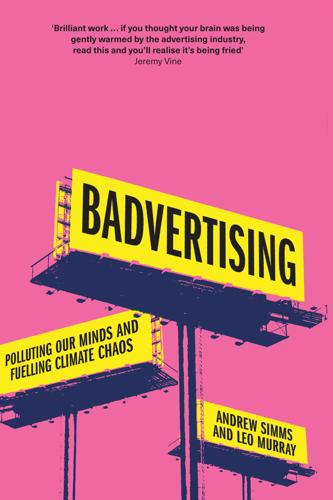
Badvertising
by
Andrew Simms
The popularity of flying on package holidays to the Mediterranean grew from the 1960s onwards, reshaping Spanish and other coastlines as sleepy fishing villages turned into vast avenues of concrete hotels facing increasingly crowded beaches. The next step came with the rise of the budget airline, or ‘low-cost carrier’ in the early 1980s. In the USA they were boosted by the airline deregulation of 1978 and the demise of the Civil Aeronautics Board in 1984 which had closely managed the industry, while protectionism amongst European countries meant deregulation took ten years to complete from the start of the process in 1987. Airlines like Pacific Southwest, New York Air and Jet America set the model and the relative cost of flying plummeted.
…
By 1973, South Western Airlines were openly saying that when they interviewed women to be stewardesses, they used to ‘start with the legs and work their way to their faces’.36 ‘The girls must be able to wear kinky leather boots and hot pants or they don’t get the job’, said a company spokesperson.37 Consequently, American stewardesses became one of the first groups to file a case under the country’s Civil Rights Act, which made discriminatory hiring practices illegal, and over the course of the 1970s the highly sexualised ‘air stewardesses’ slowly became the gender-neutral ‘flight attendants’ who serve air passengers today. Figure 6.4 Pacific Southwest Airlines stewardess, 1970s. (Pacific Southwest Airlines) Deregulation of the US airline industry in the late 1970s was hugely disruptive to the incumbent players, but the overall effect was to drastically cut ticket prices, eventually across the entire global aviation market. Freedom to compete on ticket price and growing economies of scale combined with the uniquely generous fuel tax breaks discussed above to create a whole new form of travel – the package holiday – and a whole new type of aviation business – the low-cost carrier.
…
Even in 1997, this might have been possible – but having failed to get the ban through during Tony Blair’s first term – it may well not have been passed at all if it had not been for the intervention by Lord Clement-Jones and the Liberal Democrat peers. Like the tobacco industry, the oil companies on which the car and airline industries depend also knew more about the damage their products caused than they publicly admitted. This is revealed in a report, ‘Review of Environmental Protection Activities for 1978–1979’, produced by Imperial Oil, Exxon’s Canadian subsidiary in 1980, more than a decade before the signing of the UN Framework Convention on Climate Change.50 This spelt out the level of understanding and awareness in the industry: It is assumed that the major contributors of CO2 are the burning of fossil fuels … There is no doubt that increases in fossil fuel usage and decreases of forest cover are aggravating the potential problem of increased CO2 in the atmosphere.
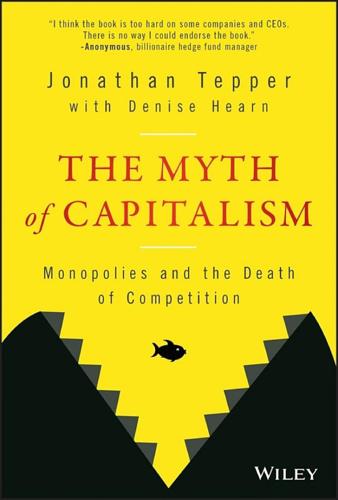
The Myth of Capitalism: Monopolies and the Death of Competition
by
Jonathan Tepper
Published 20 Nov 2018
Antitrust and Competition Policy Amid the New Merger Wave,” July 27, 2017, http://equitablegrowth.org/report/u-s-merger-policy-amid-the-new-merger-wave/. 19. https://news.yale.edu/2015/12/15/hospital-prices-show-mind-boggling-variation-across-us-driving-health-care-costs and http://www.healthcarepricingproject.org/papers/paper-1. 20. http://thehealthcareblog.com/blog/2017/02/28/drexit-costs-of-a-hospital-monopoly-in-one-underserved-county/. 21. http://www.modernhealthcare.com/article/20170413/NEWS/170419935. 22. https://www.economist.com/news/finance-and-economics/21725552-new-research-suggests-too-little-competition-deters-investment-americas. 23. Paul S. Dempsey and Andrew R Goetz, “Airline Deregulation and Laissez-Faire Mythology,” ABC-CLIO (September 8, 1992): 252. 24. “Why It Costs So Much to Fly From These Airports,” Wall Street Journal, August 25, 2011; https://centreforaviation.com/insights/analysis/houston-intercontinental-airport-enjoys-solid-traffic-growth-and-wins-new-key-long-haul-service-245295; https://skift.com/2017/07/14/delta-holds-an-edge-over-competitors-by-dominating-less-competitive-markets/; http://houston.culturemap.com/news/travel/11-27-12-the-most-expensive-airport-in-america-thats-houstons-iah-again/.
…
Index 3G Capital Partners, 3–4 2010 Full Employment Act for Lawyers, Accountants, and Consultants, 182 A AB InBev, beer market dominance, 188 Acs, Zoltan, 54 Active management, performance, 202 Advanced economies, markups (increase), 228f Advanced Micro Devices (AMD), market share, 121 AdWords (Google), 88 Affordable Care Act, impact, 43, 129 Agreement (Lilburne), 235 Agreement of the People of England, An, (Lilburne), 235 Agricultural giants, profitability, 44 Agriculture Big Four, control, 34 oligopolies, 133 AIG, bailout, 190 Airlines deregulation, 126, 198 mergers, 43, 127f oligopolies, 126 Alon, Titan, 52 Alvarez, Rosemary, 35–36 Amazon conflict of interest, 104–105 criticism, 103–104 lobbying efforts/expenses, 95–96 market power, abuse, 105 network effects, self-reinforcement, 103–104 piracy, accusation, 103 predation, example, 106 third-party sales, tracking, 104 American Tobacco Company, Supreme Court dissolution, 142–143 America Online, failure, 101 AmerisourceBergen, price-fixing allegations, 131 Anheuser-Busch (AB), InBev acquisition, 43–44, 123 Annual reports, word use (frequency), 12f Antimonopolies antitrust, contrast, 244 solutions/remedies, 242–245 Antitrust attitude, change, 146 enforcement, 145-146, 229 Reagan, impact, 161 regulation, change, 158 trials, acceleration, 244–245 Antitrust and the Formation of the Postwar World (Wells), 149 Antitrust, antimonopoly (contrast), 244 Antitrust enforcement budget, 160f income inequality, contrast, 225f Antitrust Paradox, 158 Antitrust Revolution (Reagan), 159 Apple apps, sale, 91–92 Google, duopoly, 123 lobbying efforts/expenses, 95–96 Arbitration, usage, 81 Archer Daniel Midland (ADM) market dominance, 133 spying, 22 “Are US Industries Becoming More Concentrated?”
…
Shane Oliver and AMP Capital.9 It is not surprising that the United States has seen a big increase in inequality over the past 30 years. The extremes in income distribution are most clearly reflected in extraordinary CEO pay. In the US CEO pay has exploded. From 1978 to 2013, CEO compensation adjusted for inflation increased 937%. By contrast, the average worker's income grew by a pathetic 10% over the same period. To put the change in perspective, the CEO-to-worker pay ratio was 33-to-1 in 1978 and grew to 303-to-1 in 2014.10 The United States is a big outlier in terms of how vastly overpaid the top corporate officers are versus the average worker. For CEOs in the UK, the ratio is 22; in France, it's 15; and in Germany it's 12.11 US CEOs are vastly overpaid no matter how you look at it (Figure 10.4).
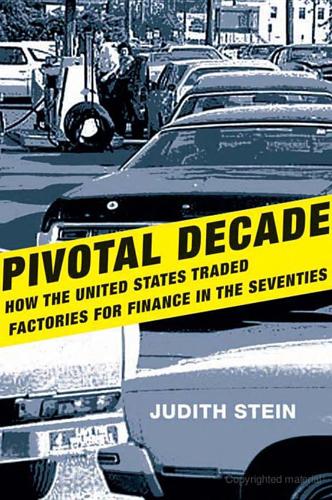
Pivotal Decade: How the United States Traded Factories for Finance in the Seventies
by
Judith Stein
Published 30 Apr 2010
Today, some historians view the National Industrial Recovery Act (NIRA) of 1933 as a leftist critique of capitalism.125 Kahn saw fascism, forestalled only by the New Deal shift from NIRA to competition in 1935. He admitted that the analogy was a little hysterical, but he passionately opposed what he believed was the alliance between business and strong unions. Kahn reminded the president that the alliance had fought trucking and airline deregulation. Now the culprits were the auto and steel industries and their unions. Kahn preferred an Economic Revitalization Board composed of people like Archibald Cox, distinguished but without industrial experience. For his economist he named Robert Solow or Gardner Ackley, both Keynesians who were neoclassical when it came to the microeconomy.126 Ralph Nader opposed the Economic Revitalization Board for similar reasons.
…
Mariani, “Republican Gains in the House in the 1994 Elections: Class Polarization in American Politics,” Political Science Quarterly, 115 (Spring 2000), 103–5. 80. Paul J. Quirk and William Cunion, “Clinton’s Domestic Policy: The Lessons of a ‘New Democrat,’” in The Clinton Legacy, ed. Colin Campbell and Bert A Rockman (New York: Chatham House, 2000), 220. 81. But the deregulation of the Carter, Reagan, and Bush years did not improve productivity. Airline deregulation evolved into the hub and spoke system, which allowed carriers to raise prices and respond ruthlessly when new carriers attempted to compete. The banking deregulation of the 1980s led to the savings and loan disasters. The deregulation of electricity raised rates. 82. Congressional Quarterly Weekly Report, 55 (Oct. 4, 1997), 2390–92. 83.
…
Landon Butler, “Memorandum for Hamilton Jordan,” Jan. 6, 1978, file Economic Tax package thru 4/78 [O/A 6148], Eizenstat papers, Jimmy Carter library and Museum, Atlanta, Ga. 72. New York Times, Apr. 2, 1978, E2. 73. New York Times, Apr. 21, 1978, 17. 74. W. Michael Blumenthal, “Memorandum for President,” Apr. 22, 1978, file Anti-Inflation [CF O/A 413], box 39, Jordan papers, Jimmy Carter Library and Museum, Atlanta, Ga. 75. Schultze, “Memorandum for President,” Mar. 13, 1978, BE4–2, WHCF, box BE-16, Jimmy Carter Library and Museum, Atlanta, Ga. 76. New York Times, Apr. 26, 1978, NJ 21. 77. New York Times, Apr. 23, 1978, F21. 78. New York Times, May 13, 1978, 5. 79.
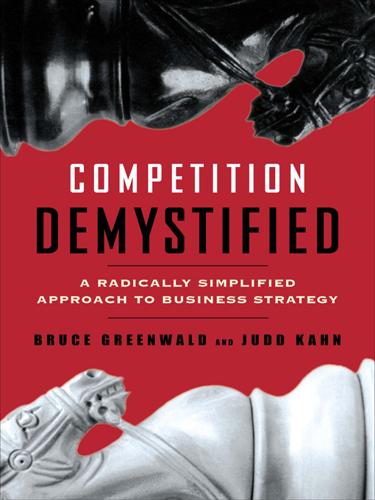
Competition Demystified
by
Bruce C. Greenwald
Published 31 Aug 2016
EVERYONE INTO THE POOL: THE END OF REGULATION By 1978, liberals and conservatives had joined forces to push for deregulation. There was some apprehension that travelers might be gouged if they had only one airline to choose from for a specific destination, but economists argued that since barriers to entry were so low, a competitor would quickly enter any market supporting excessive fares. President Carter had appointed economist Alfred Kahn as chairman of the CAB, and Kahn was thoroughly committed to ending the regulatory regime. Congress passed and Carter signed the Airline Deregulation Act in October 1978. Under its provisions, the CAB would no longer regulate fares or routes; airlines would be free to fly where they wanted and charge what they liked.
…
Bennett Stewart’s The Quest for Value (New York: HarperBusiness, 1991) has a detailed discussion of more precise ways of measuring ROIC by one of the originators of Economic Value Added analysis. INDEX ABC competitors strength Accounting. See Valuation Acquisitions. See Mergers and acquisitions Adobe Advanced Micro Devices. See AMD Advertising. See Marketing Aetna Aggression avoiding costs nature of Airbus Aircraft industry Airline Deregulation Act Airline industry barriers to entry buyouts customer loyalty programs deregulation direct competition avoidance government regulation hub-and-spoke system industry map market segments market share stability price competition in returns technology travel agent relations yield management AMD (Advanced Micro Devices) Intel v.
…
The price cutting, improved quality, and the attention brought to instant photography by both companies’ stepped-up advertising campaigns expanded the overall market for instants. In 1975, they represented 25 percent of all still cameras sold to amateurs; in 1978, the share had increased to 45 percent. For Kodak, however, that growth was a mixed blessing. It was, after all, the dominant seller of regular cameras and film. Unfortunately, 1978 proved to be a high-water mark both for instant cameras and for Kodak. A wave of high-quality, relatively inexpensive, and easy-to-use cameras based on the 35mm film format began to arrive from Japan. Even with processing costs included, 35mm film was cheaper than instant.
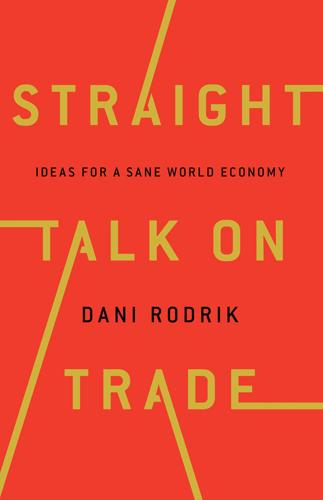
Straight Talk on Trade: Ideas for a Sane World Economy
by
Dani Rodrik
Published 8 Oct 2017
In their book, Leighton and López place special emphasis on political entrepreneurship in making policy reform possible.14 For new ideas to overcome vested interests, they write, it must be the case that “entrepreneurs notice and exploit those loose spots in the structure of ideas, institutions, and incentives.”15 They provide four case studies of this process: spectrum license auctions, airline deregulation, welfare reform, and housing finance. In their words: “[T]he public face of political change may be that of a madman, an intellectual, or an academic scribbler. But whatever form these leaders may take, they are political entrepreneurs—people whose ideas and actions are focused on producing change.”16 As these authors stress, political entrepreneurship can be socially harmful, as when the pursuit of individual rents comes at the expense of overall inefficiency.
…
Planners were simply wise enough to understand that these markets-at-the-margin enriched farmers without harming the state, as long as the plan quotas themselves were enforced, and then built public policy on that understanding. Similarly, experiments with “supersaver fares” in California and Texas greatly facilitated US airline deregulation during the 1970s by revealing the sizable price benefits of greater competition and freer entry.19 James Leitzel has written insightfully on the reformist consequences of what he calls “rule evasion.”20 As he notes, “evasive behavior in essence presents an experiment, an alternative way of arranging society.”21 Leitzel discusses two reasons why rule evasion paves the ground for new policies.
…
Indira Gandhi’s switch was further reinforced, in a more explicit manner, by Rajiv Gandhi after his rise to power in 1984. This seems to have been the key change that unleashed what Keynes called the “animal spirits” of the Indian private sector. The moral of the Indian story is that in economies that suffer from multiple distortions, small changes can make a big difference. The Chinese growth acceleration after 1978 very much bears this out. The Chinese economic takeoff wasn’t the product of economy-wide reforms or a major liberalization. It was the consequence of specific reforms that loosened collective farming rules and allowed farmers to sell excess production—after state quotas were fulfilled—at uncontrolled market prices.
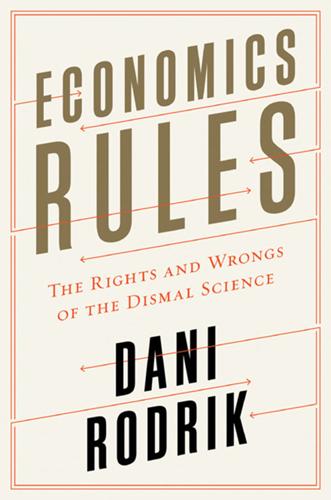
Economics Rules: The Rights and Wrongs of the Dismal Science
by
Dani Rodrik
Published 12 Oct 2015
The economists whose voices are heard have either strong convictions, or a willingness to overlook the fine print on policy recommendations. Or both. It is these advocates, with a clear position on the issues, who have a natural advantage in the media, think tanks, and government corridors. Often they are successful “policy entrepreneurs” who make a difference for the better. Auctions of wireless spectrum rights and airline deregulation were both ideas that committed economists convinced politicians to adopt.14 In other cases, as we’ve seen, the ideas being trumpeted may be more doubtful, and the advocates’ pronouncements may be looked upon with skepticism, or even scorn, by the rest of the profession. But few economist critics will be troubled to challenge them publicly.
…
Macroeconomic Effects of Fiscal Consolidation,” in World Economic Outlook (Washington, DC: International Monetary Fund, 2010), 93–124, http://www.imf.org/external/pubs/ft/weo/2010/02/pdf/c3.pdf. 5. Ariel Rubinstein, “Dilemmas of an Economic Theorist,” Econometrica 74, no. 4 (July 2006): 881. 6. Allan Gibbard and Hal R. Varian, “Economic Models,” Journal of Philosophy 75, no. 11 (November 1978): 666. 7. Nancy Cartwright, “Models: Fables v. Parables,” Insights (Durham Institute of Advanced Study) 1, no. 11 (2008). 8. The Colombia study I’m referring to is the well-known paper by Joshua Angrist, Eric Bettinger, and Michael Kremer: “Long-Term Educational Consequences of Secondary School Vouchers: Evidence from Administrative Records in Colombia,” American Economic Review 96, no. 3 (2006): 847–62. 9.
…
Nancy Cartwright, Hunting Causes and Using Them: Approaches in Philosophy and Economics (Cambridge: Cambridge University Press, 2007), 217. 14. Thomas C. Schelling, The Strategy of Conflict (Cambridge, MA: Harvard University Press, 1960); Schelling, Micromotives and Macrobehavior (New York: W. W. Norton, 1978). 15. Diego Gambetta, “‘Claro!’ An Essay on Discursive Machismo,” in Deliberative Democracy, ed. Jon Elster (Cambridge: Cambridge University Press, 1998), 24. 16. Marialaura Pesce, “The Veto Mechanism in Atomic Differential Information Economies,” Journal of Mathematical Economics 53 (2014): 33–45. 17.

Shorting the Grid: The Hidden Fragility of Our Electric Grid
by
Meredith. Angwin
Published 18 Oct 2020
Also the RTO areas have higher prices for electricity than non-RTO areas. Therefore, calling the RTO areas “deregulated” is a misnomer. In this book, I will call them “RTO areas.” Another question needs to be answered: Assuming RTO areas are some kind of market, would this market keep reliability high? Airline deregulation kept safety, and phone deregulation kept reliability. Would RTO areas keep reliability? Mostly, reliability remained high. In an RTO area, there are basically three types of utilities. Generation utilities own facilities that generate power. They are often called “merchant generators.” Distribution utilities own the distribution systems that distribute power.
…
The safety-regulation part of the regulatory scheme stayed in place and perhaps was even enhanced. Since utility operations have the potential for all sorts of accidents, from live wires falling on a road to explosions at fossil and nuclear power plants (and let’s not forget dam failure), the improving safety record of the airline industry was a good argument for utility deregulation. Airline deregulation showed that deregulation did not have to affect safety. Telephones Not many people today remember the strict monopoly powers of Ma Bell, a monopoly that mostly ended in 1982. Long-distance calls were madly expensive, calling from a hotel was a mini-nightmare, where the hotel switchboard patched you through to an AT&T long-distance operator.
…
Norton & Company, 2011). 2 Meredith and George Angwin, Voices for Vermont Yankee (Carnot Communications, 2013). 3 Meredith Angwin, Campaigning for Clean Air: Strategies for Pro-Nuclear Advocacy, (Carnot Communications, 2016). 4 Elijah R. Perry, Meredith J. Angwin, Mario Rabinowitz, John F. Shimschock. Means for protecting underground electrical equipment from thermal runaway. US Patent 4,097,682, filed August 27, 1976, and issued June 27, 1978. https://patents.google.com/patent/US4097682/un. 5 Meredith J. Angwin, Yes Vermont Yankee, http://yesvy.blogspot.com/. 6 The newspaper article was based on the ISO-NE press release “Final Capacity Auction Results: Surplus Resources Available for 2013–2014,” Business Wire, August 30, 2010. https://www.businesswire.com/news/home/20100830006350/en/Final-Capacity-Auction-Results-Surplus-Resources-2013–2014. 7 This graphic is updated every few minutes.

The Making of Global Capitalism
by
Leo Panitch
and
Sam Gindin
Published 8 Oct 2012
Once the Democrats were in office, however, the extensive capitalist mobilizations against the consumer protection and labor law reforms on the legislative agenda led to “a massive outpouring of ‘grassroots’ opposition by state and local interests.”14 In fact, the rise of a new populism on the right (most prominently expressed in the Proposition 13 tax revolt in California), combined with Democratic pledges to restrain deficits, put not only organized labor but also the broader social movements on the defensive.15 Labor suffered another major defeat with the passage of the Airline Deregulation Act in October 1978, which it correctly saw would have the effect of driving down airline workers’ wages and benefits through the removal of price controls, as well as leading to the concentration of the industry once price competition had driven out small carriers. The Act’s leading sponsor in the Senate was Edward Kennedy, and in fact Carter himself had put deregulation of the transportation industries near the top of his legislative agenda.
…
Index Abdelal, Rawi, 417n80 Acheson, Dean, 68–9, 79, 94–5, 363n9, 373n24 accounting standards, 278, 285–6, 290, 428n35 advertising, 50, 101, 137, 163 Africa, 18, 218–20, 244, 276, 373n24; see also individual countries agriculture, 26–31, 33, 42, 54, 98, 101, 147, 156, 332, 392n103 Agriculture, Department of, 359n.49, 408, n.87 Albo, Greg, 445n22 Akard, Patrick, 394n7 Aldrich Committee, 372n15 Allende, Salvador, 133, 216 AIG, 306, 315, 439.48 Airline Deregulation Act (1978), 166 Akyuz, Yilmaz, 429n46, 434n6 Alternative Economic Strategy (UK), 143, 158 American Bankers Association, 79, 169, 324 American decline (thesis of), 1, 13, 16, 183, 188–9, 201, 331, 400n94 American Dream, 173, 192, 270, 307, 340 American Enterprise Institute, 230 American Federation of Labor (AFL), 34, 49, 61, 83, 98, 164–5, 170, 271 Americanization, 31, 118, 199–203 “An American Proposal”, 67–8, 244, 337, 362n1, 362n3 Anderson, Benedict, 105 Anderson, Perry, 25–6, 100, 375n50 Andrews, David, 123, 381n36.
…
Amid this consensus the Democrats’ Keynesianism increasingly looked threadbare and confused.18 The federal deficit as a share of GDP fell from 4.2 percent in 1976 under Ford to 2.7 percent under Carter in both 1977 and 1978, and 1.6 percent in 1979. Yet since US growth rates in this period nevertheless exceeded those of most of the other advanced capitalist countries, thereby widening US trade deficits, the Carter administration’s lingering Keynesian commitments were increasingly focused on using the new G7 architecture to launch a joint “locomotive” strategy for economic expansion. Although this was reluctantly agreed to by Japan and Germany at the 1978 Bonn Summit, the response of the financial markets to seeing the US trying to turn the G7 away from its initial policy of fostering monetary restraint was a sustained assault on the dollar.
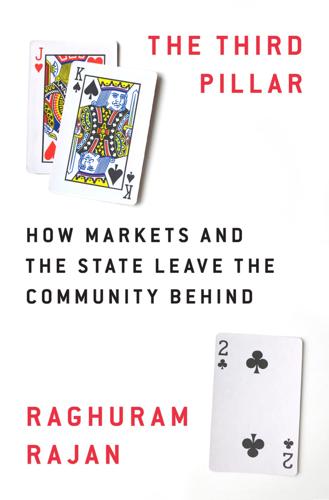
The Third Pillar: How Markets and the State Leave the Community Behind
by
Raghuram Rajan
Published 26 Feb 2019
Since being set up in 1938, the US Civil Aeronautics Board assumed powers to award routes to carriers, to regulate the entry of new carriers, and to approve fares. In exercising these powers, it typically favored incumbents. Ticket prices were high, service was good, and pay as well as travel perks were excellent for those who could get jobs in airlines. Airline pilots and air stewards led a glamorous and much-envied existence. Airline deregulation in 1978, driven by economist Alfred Kahn under the Carter administration, changed all this. Prices of tickets fell steadily, airports became more congested as air travel was no longer a preserve of the elite, service quality fell as airlines cut out the frills and focused on getting people from point to point on time, and airline worker benefits were cut steadily as new airlines entered and challenged existing ones.
…
She had a vision of an individualistic market economy, shepherded by a strong but limited state, with no real place for social structures, the community, that might balance the two. She pushed toward this goal whenever opportunities arose. As she put it to the doubters in her party, “You turn if you want. The lady’s not for turning.” Across developed countries, states liberalized not just the industrial sector but also financial markets. As with airline deregulation, competition among financial institutions and on market exchanges reduced the public’s costs and improved its access to financial services. It also led to narrower margins and lower intrinsic profitability for financial-sector firms, greater volatility in financial markets, and greater pressure to innovate and take risks.
…
In the critical sector of information technology, media, and communications, the Economist magazine found the top four firms now accounted for nearly 50 percent of the revenue.49 Concentration has been made easier by a more lax antitrust environment, as argued by my colleague Sam Peltzman.50 Right until the early 1980s, antitrust authorities were quite active in preventing mergers that increased industry concentration substantially. The legal scholar Robert Bork (yes, he of the failed Supreme Court nomination) argued in his book The Antitrust Paradox in 1978 that it is possible that rising concentration in an industry may reflect gains in market share for more efficient players rather than growing monopolization.51 He urged antitrust regulators to focus on whether the consumer was better off rather than whether industry was dominated by a few firms. In a sense, Bork pushed for a focus on outcomes such as whether the customer got a better price rather than whether the industry structure and processes would allow it to be monopolized.
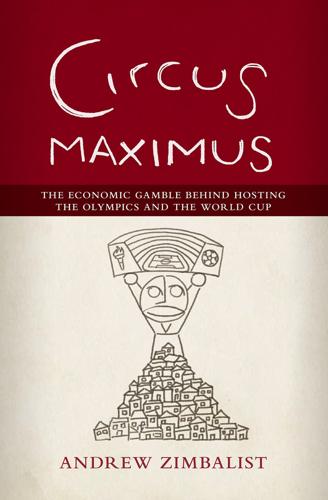
Circus Maximus: The Economic Gamble Behind Hosting the Olympics and the World Cup
by
Andrew Zimbalist
Published 13 Jan 2015
Of the thirty-seven venues used during the games, twenty-seven preexisted and five more were already under construction. Fully 83 percent of the total cost was connected to nonsports facilities. Barcelona's location, climate, architecture, and culture, as well as its entry into the European Common Market, regional airline deregulation, and intelligent marketing, were also key elements. However, just as monopolists won't surrender power voluntarily and will be inclined toward minimalist, cosmetic reform, city and country politicians will be concerned with not alienating their donors and the most powerful elements in their constituencies.
…
This way the take from business advertising expenditures could be maximized by not having to stretch corporate promotional budgets to cover two large competitions in the same year.39 Henceforth the games would alternate every two years, commencing with the Winter Games in Lillehammer in 1994. The Olympics were ascendant again, and aspiring host cities were springing up around the globe. The number of applicants went from one in the case of Los Angeles (to which the games were awarded in May 1978) and two in the case of Seoul (awarded in September 1981) to six in the case of Barcelona (awarded in October 1986), six in Atlanta (awarded in September 1990), eight in Sydney (awarded in September 1993), and eleven in Athens (awarded in September 1997).40 Thus, everything was turning up roses for the IOC—perhaps too many roses.
…
ABC paid the IOC $225 million for U.S. rights, and managed to turn a nifty profit of more than $400 million. The U.S. ratings soared, and ABC was able to charge $250,000 for a thirty-second advertising spot. Meanwhile, Peter Ueberroth thanked the thousands of volunteers and paid himself a modest bonus of $475,000. 37. There was actually a crack in the armor of amateurism under Lord Killanin. In 1978, Rule 26 of the Olympic Charter was modified so that athletes were allowed openly to earn money from endorsements if the money went to their national sports federation or their country's Olympic Committee. The receiving organization was then permitted to pay the athlete's expenses in connection with the games, including “pocket money.”

Damsel in Distressed: My Life in the Golden Age of Hedge Funds
by
Dominique Mielle
Published 6 Sep 2021
The seismic shock to the airline industry made it a logical investment area to follow for a distressed investor. Granted, it had always been prone to financial distress and bankruptcies and was naturally on the radar. From the ’70s to the early 2000s, Continental had filed for bankruptcy twice and TWA three times—all told, from the Airline Deregulation Act in 1978 (which ended U.S. federal government control over fares, routes, and market entry of new airlines) until 2001, I counted 146 airlines going belly-up. As an industry, airlines suffer from being highly capital intensive (the expensive planes), subject to a frighteningly volatile main cost (oil prices), and an economically sensitive demand (passenger growth is correlated to gross domestic product growth).
…
Barber and Terrance Odean, “Boys Will Be Boys: Gender, Overconfidence, and Common Stock Investment,” The Quarterly Journal of Economics, February 2001, https://academic.oup.com/qje/article-abstract/116/1/261/1939000?redirectedFrom=fulltext 2 Pauline R. Clance and Suzanne A. Imes, “The Impostor Phenomenon in High Achieving Women: Dynamics and Therapeutic Intervention,” Psychotherapy Theory, Research and Practice, Fall 1978, https://psycnet.apa.org/record/1979-26502-001 3 Stacey Chin, Alexis Krivkovich, and Marie-Claude Nadeau, “Constraints into preference: Gender, status and emerging career aspirations,” Sept. 6, 2018, https://www.mckinsey.com/industries/financial-services/our-insights/closing-the-gap-leadership-perspectives-on-promoting-women-in-financial-services 4 Amy J.
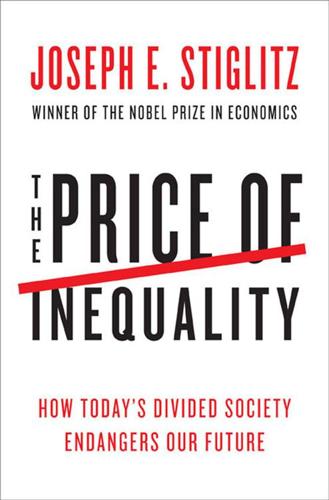
The Price of Inequality: How Today's Divided Society Endangers Our Future
by
Joseph E. Stiglitz
Published 10 Jun 2012
But it should be understood that many at that great university are not devotees of this school of thought, and that there are many devotees in other universities around the world. The term has, however, become a commonly used shorthand. 32. One group even went so far as to argue that markets will behave competitively even if there is only one firm, so long as there is potential competition. This argument played an important role in airline deregulation, where it was contended that even if there was only one airline on a given route, it would be disciplined from charging monopoly prices by the threat of entry. Both theory and experience have shown that this argument is wrong, so long as there are sunk costs (costs that won’t be recovered if a firm enters and subsequently leaves), no matter how small those costs.
…
INDEX Abed, Fazle Hasan, 196 Acacia Research Corporation, 203 Accenture, 360 advertising, 147, 335, 348, 354 see also marketing affirmative action, 282 Afghanistan, 143, 176, 209, 211, 218 Africa, 23, 40 African Americans: discrimination against, 68, 69, 70, 71, 129, 303, 305, 308, 328, 367, 369 disenfranchisement of, 345, 349 wealth of, 13, 70, 71, 329, 384 agriculture: government subsidies in, 51, 64, 179, 180, 320, 326, 379 in Great Depression, 56–57, 231, 233 AIG, 35, 49, 67, 180, 253, 369 airlines, deregulation of, 317 air traffic controllers, 65 Alien Torts Statute, 59 Ally, 374 Alperovitz, Gar, 78 alternative minimum tax, 394 American Airlines, 318 American Tobacco Company, 317 Andreessen, Marc, 318 Angelides, Phil, 372 antiglobalization movement, xiii, 277 Apple, 203, 360 Arab Spring, ix–xi, xiv, 287 Archer Daniels Midland (ADM), 51, 320 Arnall, Roland, 333 Asia, 64, 157 financial crisis in, 61, 231, 352, 353 AT&T, 44, 203, 317 Atkinson, Anthony B., xxiii auction theory, 50 austerity, 207, 220, 221, 230–36 Australia, 5, 14, 18, 22, 135, 286 autoworkers, 67 balanced-budget multiplier, 217–18, 379 Bangladesh, microcredit schemes in, 196, 197 bankers: bonuses for, x, xiv, xv, 21, 79, 141, 169, 245, 247, 270, 319, 333, 363 criminal prosecution of, xvi, 70, 119, 199, 205–6, 372, 373 economic influence of, xxii–xxiii, 79–80, 240 private incentives of, 33, 34, 87, 90, 96, 109–10 risky behavior by, xi, xxiii, 37, 90, 101, 109, 171, 198, 239–40, 246, 247, 269, 270, 336, 387 see also corporations; financial markets; financial sector Bank of America, 70, 374 bankruptcy: corporate, 313 derivatives claims in, 49, 271 government regulation of, 30 personal, 10, 275, 301 reform of, 58 student debt in, 58, 94, 195, 196, 265, 271, 323, 371 see also Chapter 11; foreclosures bankruptcy law, 193–97, 201, 202, 270, 271, 284 Bardeen, John, 41 Bartel, Larry, xxiv Basov, Nikolay, 315 Bear Stearns, 388 Belgium, 19, 22, 286 Berlusconi, Silvio, 349 Bernanke, Ben, 247, 248, 252, 257, 389 Berners-Lee, Tim, 41, 315 Bhutan, 122, 312 Bilmes, Linda, 176 Bipartisan Policy Center, 207 Bischoff, Kendra, 75 BlackBerry, 203 Blankfein, Lloyd, 124 Bloomberg, Michael, xiv bondholders, 168, 240, 261 bonds, municipal, 212, 378 Bowles, Erskine, 207 Bowles-Simpson Deficit Reduction Commission, 207, 221, 379, 380 Brattain, Walter, 41 Brazil, 5, 51, 249 economic growth in, 139, 298, 353 Bridgestone/Firestone, 104 British Petroleum (BP), xviii, 99, 189, 190, 367, 374 “Buffett rule,” 395 Buffett, Warren, 77, 180, 269, 333, 395, 396 Burnham, Walter Dean, 130 Bush, George W., 71, 73, 86, 87, 97, 101, 114, 169, 177, 208, 212, 221, 228, 330, 360, 383 Bush administration, xiv, 167, 168, 171, 178 business: anticompetitive behavior in, 44–46, 317, 318 corruption in, 176 government partnerships with, 174 government regulation of, 47 innovations in, 35, 46, 41, 78, 96, 178–79, 314, 315 political power of, 47, 50, 51, 62, 95, 99, 101, 111, 131–32, 135, 136, 285, 286, 319, 325, 350 teamwork in, 113, 343 trust in, 121–22 see also corporations; financial sector business, small, 61, 167, 225, 226, 241, 245, 395 California, electricity market liberalization in, 177–78 campaign finance, 37, 47, 131–32, 135, 136, 162, 196, 200, 206, 285–86, 319, 325, 350, 373, 397 Canada, 5, 18, 19 capital, 59, 323 social, 122–23, 125, 135 capital controls, 60, 181, 182, 277, 353 capital gains, 71–72, 87, 88, 115, 211, 274, 297, 298, 315, 330, 361, 378, 395 Cardoso, Enrique, 5 Carter, Jimmy, 71 Cayman Islands, 270 cell phones, 98, 203, 274 Census Bureau, U.S., 27, 305 Central Intelligence Agency (CIA), 209 Chait, Jonathan, 19, 116–17 Chapter 11, 284, 313, 363 see also bankruptcy Chavez, Hugo, 40 Cheney, Richard, 101 Chicago school, 44–45, 47, 256, 317, 391 child care, 10, 301 Chile, 141, 258 China, 19, 54, 64, 249, 280 economic strength of, 144, 175 inflation in, 259–60 Citibank, 204–5, 369, 387 cities, community segregation in, 75–76 Citizens United v.
…
The discussion here draws upon my reflections on that essay: “Toward a General Theory of Consumerism: Reflections on Keynes’ Economic Possibilities for Our Grandchildren,” in Revisiting Keynes: Economic Possibilities for Our Grandchildren, ed. G. Piga and L. Pecchi (Cambridge: MIT Press, 2008), pp. 41–87. See also the other essays in that volume. 51. Adam Smith, Lectures on Jurisprudence, ed. Ronald L. Meek, D. D. Raphael, and Peter Stein (New York: Clarendon Press, 1978), (A) vi.54. The citation and analysis are in Daniel Luban, “Adam Smith on Vanity, Domination, and History,” Modern Intellectual History, forthcoming. 52. For the long-run survival of the planet, there’s something else wrong with America’s answer: excessive consumption of material goods leads to global warming and puts the earth in peril. 53.

Machine, Platform, Crowd: Harnessing Our Digital Future
by
Andrew McAfee
and
Erik Brynjolfsson
Published 26 Jun 2017
Mark Prigg, “Now You Can Track Your Gym Sessions Too: Peloton Teams Up with Strava App to Monitor Spin Classes—and Says It Is Also Working on Oculus Rift VR Workouts,” DailyMail.com, February 18, 2016, http://www.dailymail.co.uk/sciencetech/article-3452996/Now-track-gym-sessions-Peleton-teams-Strava-app-monitor-spin-classes-says-working-Oculus-Rift-VR-workouts.html. † The US Civil Aeronautics Board was established in 1938 to regulate the airline industry. The board essentially ensured that fares stayed artificially high for decades. The passing of the Airline Deregulation Act in 1978 removed governmental control and allowed airlines to freely set prices. It also saw the entrance of low-cost players into the market, such as the ill-fated People Express. The new airline initially grew rapidly; within five years it was flying a million customers a month and was the fifth biggest in the United States (Markus Salge and Peter M.
…
Acton, Brian, 140 additive manufacturing, 107; See also 3D printing Adore Me, 62 adults, language learning by, 68–69 advertising content platforms and, 139 data-driven decision making for, 48, 50–51 Facebook and, 8–9 radio airplay as, 148 advertising agencies, 48 advertising revenue Android as means of increasing, 166 Craigslist’s effect on, 139 free apps and, 162 print media and, 130, 132, 139 African Americans identifying gifted students, 40 and search engine bias, 51–52 aggregators, 139–40 AGI (artificial general intelligence), 71 agriculture automated milking systems, 101 drones and, 99–100 “food computers,” 272 machine learning and, 79–80 robotics and, 101–2 Airbnb future of, 319–20 hotel experience vs., 222–23 lack of assets owned by, 6–7 limits to effects on hotel industry, 221–23 network effects, 193 as O2O platform, 186 peer reviews, 209–10 rapid growth of, 9 as two-sided network, 214 value proposition compared to Uber, 222 Airline Deregulation Act, 181n airlines, revenue management by, 181–82 air travel, virtualization in, 89 Akerlof, George, 207, 210 albums, recorded music, 145 algorithms; See also data-driven decision making bias in systems, 51–53 and Cambrian Explosion of robotics, 95–96 comparing human decisions to, 56 O2O platforms and, 193 Quantopian and, 267–70 superiority to System 1 reasoning, 38–41 “algo traders,” 268; See also automated investing Alibaba, 6–8 Alipay, 174 AlphaGo, 4–6, 14, 74, 80 Alter, Lloyd, 90 Amazon automatic price changes, 47 bar code reader app, 162 data-driven product recommendations, 47 development of Web Services, 142–43 Mechanical Turk, 260 as stack, 295 warehouse robotics, 103 Amazon EC2, 143 Amazon Go, 90–91 Amazon S3, 143 Amazon Web Services (AWS), 75, 142–43 American Airlines (AA), 182 amino acid creation, 271–72 analog copies, digital copies vs., 136 “Anatomy of a Large-Scale Hypertextual Web Search Engine, The” (Page and Brin), 233 Anderson, Chris, 98–100 Anderson, Tim, 94 Andreessen, Marc on crowdfunding, 262–63 and Netscape, 34 as self-described “solutionist,” 297 on Teespring, 263–64 Android Blackberry vs., 168 contribution to Google revenue/profits, 204 iOS vs., 166–67 Angry Birds, 159–61 anonymity, digital currency and, 279–80 Antikythera mechanism, 66 APIs (application programming interfaces), 79 apophenia, 44n apparel, 186–88 Apple; See also iPhone acquiring innovation by acquiring companies, 265 and industrywide smartphone profits, 204 leveraging of platforms by, 331 Postmates and, 173, 185 profitability (2015), 204 revenue from paid apps, 164 “Rip, Mix, Burn” slogan, 144n as stack, 295 application programming interfaces (APIs), 79 AppNexus, 139 apps; See also platforms for banking, 89–90 demand curve and, 157–61 iPhone, 151–53 App Store, 158 Apter, Zach, 183 Aral, Sinan, 33 Archilochus, 60–61 architecture, computer-designed, 118 Aristophanes, 200 Arnaout, Ramy, 253 Arthur, Brian, 47–48 artificial general intelligence (AGI), 71 artificial hands, 272–75 artificial intelligence; See also machine learning current state of, 74–76 defined, 67 early attempts, 67–74 implications for future, 329–30 rule-based, 69–72 statistical pattern recognition and, 72–74 Art of Thinking Clearly, The (Dobelli), 43 arts, digital creativity in, 117–18 Ashenfelter, Orley, 38–39 ASICs (application-specific integrated circuits), 287 assets and incentives, 316 leveraging with O2O platforms, 196–97 replacement by platforms, 6–10 asymmetries of information, 206–10 asymptoting, 96 Atkeson, Andrew, 21 ATMs, 89 AT&T, 96, 130 August (smart door lock), 163 Austin, Texas, 223 Australia, 100 Authorize.Net, 171 Autodesk, 114–16, 119, 120 automated investing, 266–70 automation, effect on employment/wages, 332–33 automobiles, See cars Autor, David, 72, 101 background checks, 208, 209 back-office work, 82–83 BackRub, 233 Baidu, 192 Bakos, Yannis, 147n Bakunin, Mikhail, 278 Ballmer, Steve, 151–52 bandwagon effect, 217 banking, virtualization and, 89–90, 92 Bank of England, 280n bank tellers, 92 Barksdale, Jim, 145–46 barriers to entry, 96, 220 Bass, Carl, 106–7, 119–20 B2B (business-to-business) services, 188–90 Beastmode 2.0 Royale Chukkah, 290 Behance, 261 behavioral economics, 35, 43 Bell, Kristen, 261, 262 Benioff, Mark, 84–85 Benjamin, Robert, 311 Benson, Buster, 43–44 Berlin, Isiah, 60n Berners-Lee, Tim, 33, 34n, 138, 233 Bernstein, Michael, 260 Bertsimas, Dimitris, 39 Bezos, Jeff, 132, 142 bias of Airbnb hosts, 209–10 in algorithmic systems, 51–53 digital design’s freedom from, 116 management’s need to acknowledge, 323–24 and second-machine-age companies, 325 big data and Cambrian Explosion of robotics, 95 and credit scores, 46 and machine learning, 75–76 biology, computational, 116–17 Bird, Andrew, 121 Bitcoin, 279–88 China’s dominance of mining, 306–7 failure mode of, 317 fluctuation of value, 288 ledger for, 280–87 as model for larger economy, 296–97 recent troubles with, 305–7 and solutionism, 297 “Bitcoin: A Peer-to-Peer Electronic Cash System” (Nakamoto), 279 BlaBlaCar, 190–91, 197, 208 BlackBerry, 168, 203 Blitstein, Ryan, 117 blockchain as challenge to stacks, 298 and contracts, 291–95 development and deployment, 283–87 failure of, 317 and solutionism, 297 value as ledger beyond Bitcoin, 288–91 Blockchain Revolution (Tapscott and Tapscott), 298 Bloomberg Markets, 267 BMO Capital Markets, 204n Bobadilla-Suarez, Sebastian, 58n–59n Bock, Laszlo, 56–58 bonds, 131, 134 bonuses, credit card, 216 Bordeaux wines, 38–39 Boudreau, Kevin, 252–54 Bowie, David, 131, 134, 148 Bowie bonds, 131, 134 brand building, 210–11 Brat, Ilan, 12 Bredeche, Jean, 267 Brin, Sergey, 233 Broward County, Florida, 40 Brown, Joshua, 81–82 Brusson, Nicolas, 190 Burr, Donald, 177 Bush, Vannevar, 33 business conference venues, 189 Business Insider, 179 business processes, robotics and, 88–89 business process reengineering, 32–35 business travelers, lodging needs of, 222–23 Busque, Leah, 265 Buterin, Vitalik, 304–5 Byrne, Patrick, 290 Cairncross, Francis, 137 California, 208; See also specific cities Calo, Ryan, 52 Cambrian Explosion, 94–98 Cameron, Oliver, 324 Camp, Garrett, 200 capacity, perishing inventory and, 181 Card, David, 40 Care.com, 261 cars automated race car design, 114–16 autonomous, 17, 81–82 decline in ownership of, 197 cash, Bitcoin as equivalent to, 279 Casio QV-10 digital camera, 131 Caves, Richard, 23 Caviar, 186 CDs (compact discs), 145 cell phones, 129–30, 134–35; See also iPhone; smartphones Census Bureau, US, 42 central bankers, 305 centrally planned economies, 235–37 Chabris, Chris, 3 Chambers, Ephraim, 246 Champy, James, 32, 34–35, 37, 59 Chandler, Alfred, 309n Chase, 162 Chase Paymentech, 171 check-deposit app, 162 children, language learning by, 67–69 China Alibaba in, 7–8 concentration of Bitcoin wealth in, 306–7 and failure mode of Bitcoin, 317 mobile O2O platforms, 191–92 online payment service problems, 172 robotics in restaurants, 93 Shanghai Tower design, 118 Xiaomi, 203 Chipotle, 185 Choudary, Sangeet, 148 Christensen, Clay, 22, 264 Churchill, Winston, 301 Civil Aeronautics Board, US, 181n Civis Analytics, 50–51 Clash of Clans, 218 classified advertising revenue, 130, 132, 139 ClassPass, 205, 210 and economics of perishing inventory, 180–81 future of, 319–20 and problems with Unlimited offerings, 178–80, 184 and revenue management, 181–84 user experience, 211 ClassPass Unlimited, 178–79 Clear Channel, 135 clinical prediction, 41 Clinton, Hillary, 51 clothing, 186–88 cloud computing AI research, 75 APIs and, 79 Cambrian Explosion of robotics, 96–97 platform business, 195–96 coaches, 122–23, 334 Coase, Ronald, 309–13 cognitive biases, 43–46; See also bias Cohen, Steven, 270 Coles, John, 273–74 Collison, John, 171 Collison, Patrick, 171–74 Colton, Simon, 117 Columbia Record Club, 131 commoditization, 220–21 common sense, 54–55, 71, 81 companies continued dominance of, 311–12 continued relevance of, 301–27 DAO as alternative to, 301–5 decreasing life spans of, 330 economics of, 309–12 future of, 319–26 leading past the standard partnership, 323–26 management’s importance in, 320–23 markets vs., 310–11 as response to inherent incompleteness of contracts, 314–17 solutionism’s alternatives to, 297–99 TCE and, 312–15 and technologies of disruption, 307–9 Compass Fund, 267 complements (complementary goods) defined, 156 effect on supply/demand curves, 157–60 free, perfect, instant, 160–63 as key to successful platforms, 169 and open platforms, 164 platforms and, 151–68 and revenue management, 183–84 Stripe and, 173 complexity theory, 237 Composite Fund (D.

Aerotropolis
by
John D. Kasarda
and
Greg Lindsay
Published 2 Jan 2009
Between 1969 and 1978, there were more than four hundred international hijackings involving seventy-five thousand passengers as hostages. In the United States alone, there were 154 attempted hijackings to Cuba in a four-year stretch. (As one hijacker explained, it was the easiest way to get there.) The solution was X-ray machines and magnetometers, leading to the choke points we all know and despise. DFW’s in-and-out, “park-and-fly” concept never got off the ground. What they could not have foreseen was President Jimmy Carter signing the Airline Deregulation Act into law on October 24, 1978. The airlines’ business model changed overnight.
…
City of Los Angeles, 29 Abraham Lincoln National Airport, 53–56; opposition to, 57–58 Abramson, Jerry, 86 Abu Dhabi, 291, 292; Dubai vs., 206, 207, 304–305, 309–10; oil reserves in, 294 Accenture, 126 Addis Ababa, Ethiopia, 317; airport in, 321–22; Bole neighborhood of, 321; as shipping hub, 320–25 Adelson, Sheldon, 378–79 Adkins, Craig, 70, 72, 73 aerial connectivity: as boost to medical tourism, 275–76; commuting transformed by, 118–19 aerotropolis, aerotropoli: accessibility vs. location for, 170; in Bangkok, see Bangkok, Thailand; business accom-modated by, 167–68; coinage of word, 5, 383, 419; customized for floral industry, 222; design principles of, 5–6; Detroit’s plans for, 180–207; as distinct from airports, 173–74; early adopters of, 246; early indicators of, 6; early prototypes of, 169–73; evolution of, 5–6; as form of globalization, 5, 6, 8, 175–76; as frictionless, 167–68; as fuel dependent, 332; governance of, 176–77, 188, 190, 194–96; jobs created by, 19; Kasarda’s definition of, 174; as made vs. born, 79–80; New Songdo City as template for, 5, 354, 357; as physical Internet, 9–10; as product of Instant Age, 6; public perception of, 349; purpose-built suburbs around, 89–90; risk of runaway growth in, 169; Schiphol and Amsterdam as model for, 211–12; speed needed in development of, 170, 174, 192, 195–96; as suited to pace of urbanization, 19; as sustainable and green cities, 350, 353–58; Visteon Village as model of, 199, 200–201 Aerotropolis Development Corp., 195–96, 198 Africa: Chinese construction of cities and airports in, 360, 399; Chinese living in, 399; Chinese trade with, 319–20, 360, 398–400; commercialized agriculture as future for, 235–36; farming footprint in, 232; farmland available in, 235; floral industry in, 212, 216, 221, 222–24, 317, 319, 407; food imports to, 235; foreign land acquisition in, 348, 427; globalization of, 319–20, 324; SAM shipments introduced to, 318; shipment of goods to, 317–25 agriculture, sustainable, 234 Air Asia, 252 Airborne Express, 87 Airbus, 27, 173, 347; in China, 402, 406 air cargo: as cost effective, 361–62; growth of, 337–38; shipping costs in, 243, 338; value of, 17 Air China, 403 Air Deccan, 279 Air India, 280 Airline Deregulation Act, 94–95, 123 airline loyalty programs, 102 airlines, airline industry: adapting to fuel prices, 340–41; bankruptcy filed by, 331; expansion of, 276; Eyjafjallajökull interruption of, 17–18; globalization and, 17–18; as increasingly green, 21–22, 345–49; Kyoto exemption for, 346; lip service to climate change paid by, 346; share of GDP, 347 airports: adaptability problems with, 16, 35, 96, 372; aerotropoli as distinct from, 173–74; along Pacific Rim, 29; carbon neutral goal of, 351; early plans for, 26; improving sustainability of, 350; instant cities near, 358; jobs created by, 30, 87, 114, 174, 190; layovers in, 96–98; municipal neglect of, 26, 32, 352; noise pollution around, 28–29, 86; politization of, 26, 46–47, 48–49, 170, 188, 256, 281; poorly planned, 350; public perception of, 32–33, 349; residential areas around, 22–24, 28–29, 40, 45, 46, 64, 86–90, 146–47, 197; as shopping malls, 96, 422; space overcome by, 26; as trade and connectivity incubators, 26, 174, 350; train links to, 155–56, 351–52; Western U.S. dependency on, 33 air traffic control systems, 352–53 air transport: as central to globalization, 17; interruption of, 17–18 air travel: by business travelers, 6–7, 18; carbon footprint of, 15, 21–22, 330, 333–38; as central to globalization, 17–18, 165, 413; cost of delays in, 352; deregulation and, 94–95, 123; EU made possible by, 18; fuel needs and costs, 331, 342; greenhouse gases from, 335–37, 345; growth of, 22, 98–99, 340; increased with high-speed rail, 352; Jevons Paradox in, 328–29; as key to Pacific Rim economic development, 244; links to oil prices, 21; peak oil and, 329–33; post-peak oil, 332–33; profitability of, 331; and rise of multinationals, 165; social stigma against, 335; tourism connections made by, 265 Airworld, 97–108; business conducted within, 107–12 Akamatsu, Kaname, 391 Al Badia Hillside Village, 289, 290 Al Burj, 291 algae, oil from, 348, 350 Ali, Mwanje, 319–20 Alibaba.com, 367 Al Maktoum, Mohammed bin Rashid, 290–91, 292, 294, 295 Al Maktoum, Rashid bin Saeed, 294–95 Al Nahyan, Khalifa bin Zayed, 292 Amazon, 75–77; business expansion of, 72; shipping costs at, 70, 75–76; Zappos bought by, 69 Amazon Prime, 75–76, 422 Ambani, Anil, 283 Amelio, Bill, 125 American Airlines, 27, 48, 102; hubbing created by, 92, 95–96 American Axle, 201 America Online, 41–42 Amsterdam: as aerotropolis by design, 20; Detroit delegation in, 180–81, 183–84, 189–92, 425; floral industry in, 24, 209–25, 407; Zuidas business district in, 191 Amsterdam Airport Area, 190 Amyris, 348 Andersen, Kurt, 386 Andolino, Rosemarie, 50–51 Annan, Kofi, 264 Apple, 371, 396–97 Applebaum, Anne, 18 Asia: Detroit’s air links to, 182; FedEx hubs in, 171, 372–73, 384, 433; investment in aviation across, 244–45; as largest aviation market, 402 Asian financial crisis, 353–54 Asian Tigers, 244, 391–92, 394 assembly line production, Ford’s creation of, 68, 179, 180, 185, 186 Association of Southeast Asian Nations (ASEAN), 400–401, 402–403 ASUSTeK, 370–71 Atlantic, The, 204, 361 Australia, 400 automotive industry: in China, 200, 203–207, 337,342, 409; Chinese acquisition and investment in U.S., 205–207; cities as shaped by, 11; in Detroit, 179–80, 184–87; economic impact of, 425–26; engineering within, 201–202; growth markets for, 200, 203–207; outsourcing in, 202–203; as part of GDP, 186; railroad decline hastened by, 243; results of globalization of, 269; in South Korea, 203–205; supply chains of, 199; U.S. market for, 186–87, 200, 201, 337 aviation and aerospace industry: in California, 26, 27–29; carbon footprint of, 430–31; during Cold War, 27,28; economic impact of, 28; first flight in, 349; Ford’s operations in, 179–80; military links to, 27–28; speed of technology change in, 341; in World War II, 27 Aviation Department, Chicago, 48 babassu palms, 347 Baca, Tony, 33–34 baht, 248–49 Baiyun International, 372 Bali, Vishal, 275 Ballard, J.
…
Malcolm Gladwell made a similar point during the original dot-com madness by dropping in on the warehouse of Lands’ End. The catalog merchant was then the world’s largest e-tailer. Gladwell found that the Internet revolution, as far as it had progressed, hadn’t transformed its business. But it was one of three fundamental shifts. “The first was the introduction of an 800 number, in 1978,” he wrote. “The second was express delivery, in 1994; and the third was the introduction of a Web site, in 1995. The first two innovations cut the average transaction time—the time between the moment of ordering and the moment the goods are received—from three weeks to four days. The third innovation has cut the transaction time from four days to, well, four days.”
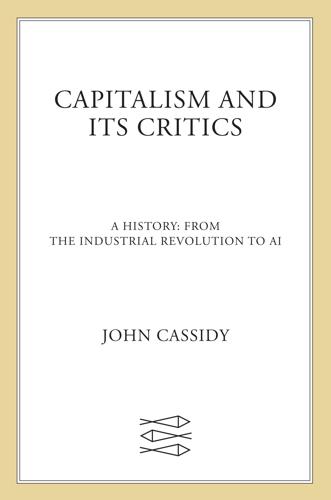
Capitalism and Its Critics: A History: From the Industrial Revolution to AI
by
John Cassidy
Published 12 May 2025
Kahn was an independent-minded academic who had no time for special pleading from the big carriers. In 1978, he helped shepherd through Congress the Airline Deregulation Act, which eliminated the federal government’s authority to set fares and made it easier for new entrants to fly routes dominated by the big carriers. These reforms revolutionized the airline industry, opening the way to an era of cheaper fares, discount airlines, crowded planes, and wage cuts for workers at legacy carriers. The philosophy behind airline deregulation was encapsulated in a remark of Breyer’s: “Why regulate something if it can be done better by the market?”
…
In the late 1970s, Chile’s inflation rate fell sharply: by 1981, it was under 10 percent.27 Business investment revived, exports rose, and in the four years from 1977 to 1980, inflation-adjusted GDP grew at an annual rate of 8.5 percent.28 However, the shock treatment also exacted heavy social and economic costs. Among Chile’s poor, the cuts to government programs caused a great deal of hardship. By 1978, inflation-adjusted wages had fallen by nearly a quarter, and close to 20 percent of the workforce was unemployed or on emergency government programs that paid minimal wages.29 Moreover, the strong GDP growth didn’t last. In late 1981 Chile experienced a foreign debt crisis. During the years of growth, it had built up big external debts.
…
If it was given too much leeway—and the proponents of deregulation wanted to give it as much as possible—it was apt to blow up and plunge the economy into a deep recession, or even a depression. “This implies that policies to control and guide the evolution of finance are necessary,” Minsky wrote in a 1978 paper.47 His language was understated, but the argument was potentially devastating to the policy of deregulating the financial system, which had begun even before Reagan came to power, with the passage of the 1980 Depository Institutions Deregulation and Monetary Control Act. (The legislation removed long-standing caps on the interest rates that banks could pay on their customer accounts.)
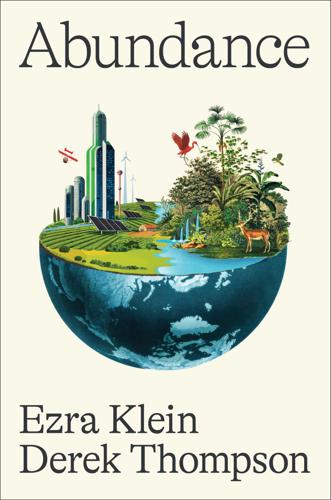
Abundance
by
Ezra Klein
and
Derek Thompson
Published 18 Mar 2025
Courtesy Office of Sen. Tom Hayden, https://images2.americanprogress.org/campus/email/PortHuronStatement.pdf. 5. Motor Carrier Act, 94 Statute 793, Public Law 96-296, 96th Congress (1980) (enacted), https://www.govinfo.gov/content/pkg/STATUTE-94/pdf/STATUTE-94-Pg793.pdf#page=1; Airline Deregulation Act, 92 Statute 1705, Public Law 95-504, 95th Congress (1978) (enacted), https://www.govinfo.gov/content/pkg/STATUTE-92/pdf/STATUTE-92-Pg1705.pdf. 6. Tax Foundation, “Historical US Federal Individual Income Tax Rates & Brackets, 1862–2021,” August 24, 2021, https://taxfoundation.org/data/all/federal/historical-income-tax-rates-brackets/; Adam Carasso and Gene Steuerle, “A Brief History of the Top Tax Rate,” Tax Policy Center, November 25, 2002, https://www.urban.org/sites/default/files/publication/59856/1000459-A-Brief-History-of-the-Top-Tax-Rate.PDF; Josephine Nesbit, “5 Presidents Who Raised Taxes the Most, and 5 Who Lowered Them: Is Trump One of Them?
…
But what of the places where society needed a supply of something that the market could not, or would not, provide on its own? This is where you might have expected Democrats to step in. But Democrats, cowed by the Reagan revolution and frightened of being seen as socialists, largely confined themselves to working on the demand side of the ledger. When Americans in 1978 heard that “government cannot solve our problems, it can’t set our goals, it cannot define our vision,” the words didn’t come from Ronald Reagan. They came from President Jimmy Carter, a Democrat, in his State of the Union address.2 This was a preview of things to come. In 1996, the next Democratic president, Bill Clinton, announced that “the era of big government is over.”3 The notion that the US government cannot solve America’s problems was not unilaterally produced by Reagan and the GOP.
…
Laffer Curve Napkin, National Museum of American History, Smithsonian Institution, September 14, 1974, https://www.si.edu/object/laffer-curve-napkin%3Anmah_1439217; “Can Countries Lower Taxes and Raise Revenues?,” Economist, June 18, 2019, https://www.economist.com/graphic-detail/2019/06/18/can-countries-lower-taxes-and-raise-revenues. 2. President Jimmy Carter, State of the Union Address Delivered Before a Joint Session of the Congress, January 19, 1978, https://www.presidency.ucsb.edu/documents/the-state-the-union-address-delivered-before-joint-session-the-congress-1. 3. President William Jefferson Clinton, State of the Union Address, US Capitol, January 23, 1996, https://clintonwhitehouse4.archives.gov/WH/New/other/sotu.html. 4. Steven Teles, Samuel Hammond, and Daniel Takash, “Cost Disease Socialism: How Subsidizing Costs While Restricting Supply Drives America’s Fiscal Imbalance,” Niskanen Center, September 9, 2021, https://www.niskanencenter.org/cost-disease-socialism-how-subsidizing-costs-while-restricting-supply-drives-americas-fiscal-imbalance/. 5.
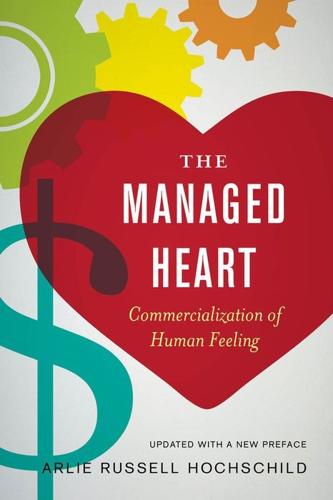
The Managed Heart: Commercialization of Human Feeling
by
Arlie Russell Hochschild
Published 1 Nov 1983
The good sport is required to empathize with the other player, but not to such an extent that he or she eliminates competition, which is one source of the fun. CHAPTER 6 1. For a detailed picture of the Delta-Eastern competition in the postwar period, see Gill and Bates (1949), p. 235. 2. The Airline Deregulation Act, passed by Congress in October 1978, provided for abolition of the CAB by 1985, after the transfer of some of its functions to other agencies has been accomplished. In 1981 the CAB lost all authority to regulate the entry of air carriers into new domestic markets. 266 Notesfor Pages 119-156 3. Braverman (1974) argues that corporate management applied the principles of Frederick Winslow Taylor and systematically divided single complex tasks into many simple tasks so that a few parts of the former complex task are done by a few highly paid mental workers while the remaining simple parts of the task are done by cheap and interchangeable unskilled workers.
…
(It now shares 80 percent of its routes with Eastern.Y The Civil Aeronautics Board (CAB), established in 1938 in recognition of the national importance of air transport and the threat of monopoly, was granted authority to control market shares and prices. Until 1978 it established uniform prices for airline tickets and sharpened competition by offering parallel route awards. Companies competed by offering more frequent flights, more seats, faster flights (fewer stops), and-what is most important here-better service. After 1978 the airlines were deregulated and price wars were allowed. 2 Yet a brief price war in 1981 and another shake-out of weaker companies has been followed by a general rise in prices.
…
The early development of a false self is an asset for the actor. As Winnicott notes, "It can easily be seen that sometimes the False Self defense can form the basis for a kind of sublimating, as when a child grows up to be an actor" (p.150). 16. Lasch (1978). We have an accumulation ofliterature now on the new "modern self' adapted to conditions of modern society: for example, Riesman (1953), Lasch (1978), Lifton (1970), Turner (1976), Zurcher (1972). These theorists suggest a general link between conditions of modern life (living in transient social worlds or being transient in stable ones, the decline of kinship ties, social mobility) and the development of a more outwardly attuned (Riesman), more protean (Lifton), more malleable sel£ In other words, their conclusion seems to be that conditions conspire to foster in us more false selves, which are more flexibly related to what we conceive as our illusive "true sel£" AFTERWORD 1.

An Extraordinary Time: The End of the Postwar Boom and the Return of the Ordinary Economy
by
Marc Levinson
Published 31 Jul 2016
McCraw, Prophets of Regulation: Charles Frances Adams, Louis D. Brandeis, James M. Landis, Alfred E. Kahn (Cambridge, MA: Harvard University Press, 1986). The laws included the Railway Revitalization and Regulatory Reform Act of 1976 (P.L. 94–201), the Air Cargo Deregulation Act of 1977 (P.L. 95–163), the Airline Deregulation Act of 1978 (P.L. 95–504), the Motor Carrier Regulatory Reform and Modernization Act of 1980 (P.L. 92–296), the Staggers Rail Act of 1980 (P.L. 96–448), the Household Goods Transportation Act of 1980 (P.L. 96–454), the Bus Regulatory Reform Act of 1982 (P.L. 97–261), and the Shipping Act of 1984 (P.L. 98–237). 21.
…
If employers in certain industries agreed to retrain workers over age forty-five, the government paid them one-fourth of a year’s wage. Yet while MITI could seem omnipotent to foreign observers, it had considerable difficulty working its will. After orders for Japan’s shipbuilders fell 90 percent between 1973 and 1978, it was obvious that the industry needed to shrink. But no community wanted to lose its local shipyard, and no company wanted to close its docks. Only in 1978, five years after the shipbuilding crisis began, did the Diet, Japan’s parliament, authorize the creation of a scrapping association funded by national and local governments, banks, trading companies, and shipbuilders. By the end of 1980, this cartel had bought and shut down fifty of Japan’s 138 shipbuilding docks, eliminating 119,000 jobs but leaving the rest of the industry on a much more solid footing.13 A similar story played out in many other industries.
…
The Fed, still under the control of Arthur Burns, had lowered interest rates in the second half of 1976 to help Gerald Ford win re-election, leaving Carter with the poisonous gift of rising inflation. Although Carter was able to push Burns out in January 1978, by then inflation was climbing back toward the double digits. As the Fed began raising overnight interest rates aggressively to clamp down on inflation, interest rates on the Treasury’s short-term bonds rose close to those on its long-term bonds. On August 18, 1978, the lines crossed: investors earned more for lending to the government for two years than for ten. That unusual condition, known in the financial markets as an inverted yield curve, was an alarm bell, an unmistakable warning that a recession was likely in the second half of 1979.
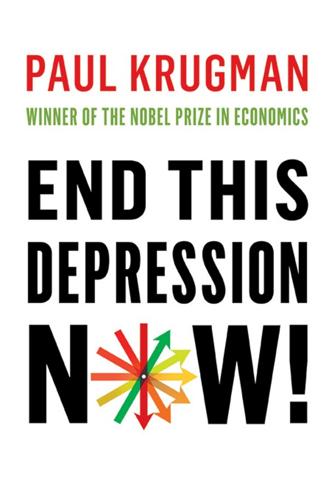
End This Depression Now!
by
Paul Krugman
Published 30 Apr 2012
ACKNOWLEDGMENTS This book reflects the contributions of all the economists who have struggled to get through with the message that this depression can and should be quickly cured. In writing the manuscript, I relied, as always, on the insights of my wife, Robin Wells, and much help from Drake McFeely at Norton. INDEX Page numbers in italics refer to figures. academic sociology, 92, 96, 103 AIG, 55 airlines, deregulation of, 61 Alesina, Alberto, 196–99 American Airlines, 127 American Recovery and Reinvestment Act (ARRA): cost of, 121 inadequacy of, 108, 109–10, 116–19, 122–26, 130–31, 212, 213 Angle, Sharron, 6 anti-Keynesians, 26, 93–96, 102–3, 106–8, 110–11, 192 Ardagna, Silvia, 197–99 Argentina, 171 Arizona, housing bubble in, 111 Asian financial crisis of 1997–98, 91 asset-backed securities, 54, 55 auction rate securities, 63 Austerians, 188–207 creditors’ interests favored by, 206–7 supposed empirical evidence of, 196–99 austerity programs: alarmists and, 191–95, 224 arguments for, 191–99 economic contraction and, 237–38 in European debt crisis, 46, 144, 185, 186, 188 as ineffective in depressions, xi, 213 state and local governments and, 213–14, 220 unemployment and, xi, 189, 203–4, 207, 237–38 Austrian economics, 150 automobile sales, 47 babysitting co-op, 26–28, 29–30, 32–33, 34 Bakija, Jon, 78 balance of trade, 28 Ball, Laurence, 218 Bank for International Settlements (BIS), 190, 191 Bank of England, 59 Bank of Japan, 216, 218 bankruptcies, personal, 84 bankruptcy, 126–27 Chapter 11, 127 banks, banking industry: capital ratios in, 58–59 complacency in, 55 definition of, 62 deregulation of, see deregulation, financial European, bailouts of, 176 government debt and, 45 “haircuts” in, 114–15 incomes in, 79–80 lending by, 30 money supply and, 32 moral hazard in, 60, 68 1930s failures in, 56 origins of, 56–57 panics in, 4, 59 political influence of, 63 receivership in, 116 regulation of, 55–56, 59–60, 100 repo in, 62 reserves in, 151, 155, 156 revolving door in, 86, 87–88 risk taking in, see risk taking runs on, 57–58, 59, 60, 114–15, 155 separation of commercial and investment banks in, 60, 62, 63 shadow, 63, 111, 114–15 unregulated innovations in, 54–55, 62–63, 83 Barro, Robert, 106–7 Bebchuck, Lucian, 81 Being There (film), 3 Bernanke, Ben, 5, 10–11, 32, 76, 104, 106, 151, 157, 159–60, 210 recovery and, 216–19 on 2008–09 crisis, 3–4 “Bernanke Must End Era of Ultra-low Rates” (Rajan), 203–4 Black, Duncan, 190 Blanchard, Olivier, 161–63 Bloomberg, Michael, 64 BNP Paribas, 113 Boehner, John, 28 bond markets: interest rates in, 132–41, 133 investor confidence and, 132, 213 bonds, high-yield (junk bonds), 115, 115 bond vigilantes, 125, 132–34, 138, 139, 140 Bowles, Erskine, 192–93 Brazil, 171 breach of trust, 80 Bretton Woods, N.H., 41 Broder, David, 201 Brüning, Heinrich, 19 Buckley, William F., 93 Bureau of Labor Statistics, U.S.
…
Assessing the effects of austerity therefore requires painstaking examination of the actual legislation used to implement that austerity. Fortunately, researchers at the International Monetary Fund have done the legwork, identifying no fewer than 173 cases of fiscal austerity in advanced countries over the period between 1978 and 2009. And what they found was that austerity policies were followed by economic contraction and higher unemployment. There’s much, much more, but I hope this brief overview gives you a sense of what we know and how we know it. I hope in particular that when you read me, or Joseph Stiglitz, or Christina Romer, saying that cutting spending in the face of this depression will make it worse, and that temporary increases in spending could help us recover, you won’t think, “Well, that’s just his/her opinion.”
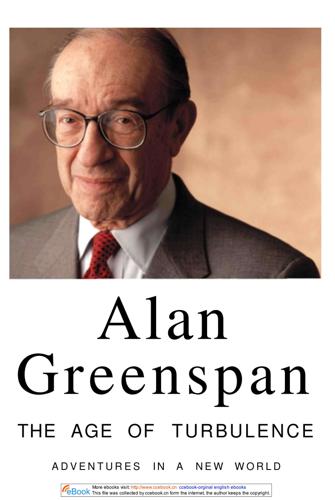
The Age of Turbulence: Adventures in a New World (Hardback) - Common
by
Alan Greenspan
Published 14 Jun 2007
Airlines, trucking, railroads, buses, pipelines, telephones, television, stockbrokers, financial markets, savings banks, utilities—all operated under heavy regulation. Operations were monitored down to the tiniest detail. My favorite description of this was by Alfred Kahn, a wisecracking economist from Cornell University whom Jimmy Carter made head of the Civil Aeronautics Board and who became known as the Father of Airline Deregulation. Speaking in 1978 on the need for change, Fred couldn't resist riffing on the thousands of picayune decisions he and the board were called upon to make: "May an air taxi acquire a fifty-seat plane? May a supplemental carrier carry horses from Florida to somewhere in the Northeast? Should 71 More ebooks visit: http://www.ccebook.cn ccebook-orginal english ebooks This file was collected by ccebook.cn form the internet, the author keeps the copyright.
…
Many of the moves that the administration and Congress made were the very ones I'd have pushed for, had I been there. 81 More ebooks visit: http://www.ccebook.cn ccebook-orginal english ebooks This file was collected by ccebook.cn form the internet, the author keeps the copyright. T H E AGE OF T U R B U L E N C E Most important, the Carter administration carried on the deregulation initiative that had begun under Jerry Ford. The airline-deregulation bill, promoted by Teddy Kennedy, passed in 1978. (Kennedy's right-hand man on this project was Stephen Breyer, who was on leave from Harvard Law School and who later became a justice of the Supreme Court and a good friend.) After that, Congress moved methodically to deregulate telecommunications and a half dozen other industries.
…
Not only did the economies of the former Soviet bloc, after some chaos, embrace the ways of market capitalism, but so did most of what we previously called the third world—countries that had been neutral in the cold war but had practiced central planning or had been so heavily regulated that it amounted to the same thing. Communist China, which had edged toward market capitalism as early as 1978, accelerated the movement of its vast, tightly regulated, then more-than-500-million-person workforce toward the Free Trade Zones of the Pearl River delta. China's shift in protecting the property rights of foreigners, while subtle, was substantial enough to induce a veritable explosion in foreign direct investment (FDI) into China following 1991.
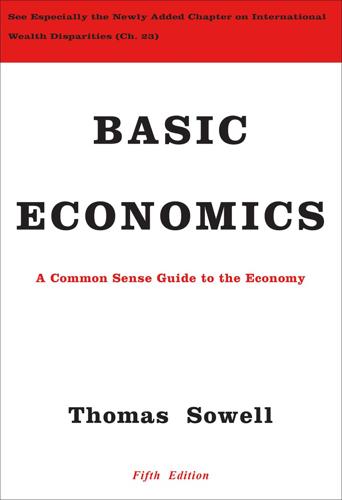
Basic Economics
by
Thomas Sowell
Published 1 Jan 2000
Savings to airline passengers ran into the billions of dollars.{247} These were not just zero-sum changes, with airlines losing what passengers gained. The country as a whole benefitted from deregulation, for the industry became more efficient. Just as there were fewer trucks driving around empty after trucking deregulation, so airplanes began to fly with a higher percentage of their seats filled with passengers after airline deregulation, and passengers usually had more choices of carriers on a given route than before. Much the same thing happened after European airlines were deregulated in 1997, as competition from new discount airlines like Ryanair forced British Airways, Air France and Lufthansa to lower their fares.{248} In these and other industries, the original rationale for regulation was to keep prices from rising excessively but, over the years, this turned into regulatory restrictions against letting prices fall to a level that would threaten the survival of existing firms.
…
{244} David Gardner, “Impossible India’s Improbable Chance,” The World in 2001 (London: The Economist Newspaper Limited, 2000), p. 46. {245} David Henderson, “Trucking Deregulation,” The Fortune Encyclopedia of Economics, edited by David Henderson (New York: Warner Books, 1993), pp. 435–436. {246} Ibid., p. 436. {247} Alfred E. Kahn, “Airline Deregulation,” Ibid., pp. 379, 380, 381. {248} Kerry Capell, et al., “A Closer Continent,” BusinessWeek, May 8, 2006, pp. 44–45. {249} Chris Serres, “Retail Starting to Turn Green,” San Francisco Chronicle, August 19, 2007, p. F1. {250} Federal Trade Commission v. Morton Salt Co., 334 U.S. 37 (1948), at 41, 46
…
In China, the transition to a market economy began earlier, in the 1980s. Government controls were at first relaxed on an experimental basis in particular economic sectors and in particular geographic regions earlier than in others. This led to stunning economic contrasts within the same country, as well as rapid economic growth overall. Back in 1978, less than 10 percent of China’s agricultural output was sold in open markets, instead of being turned over to the government for distribution. But, by 1990, 80 percent was sold directly in the market.{28} The net result was more food and a greater variety of food available to city dwellers in China, and a rise in farmers’ income by more than 50 percent within a few years.{29} In contrast to China’s severe economic problems when there was heavy-handed government control under Mao, who died in 1976, the subsequent freeing up of prices in the marketplace led to an astonishing economic growth rate of 9 percent per year between 1978 and 1995.
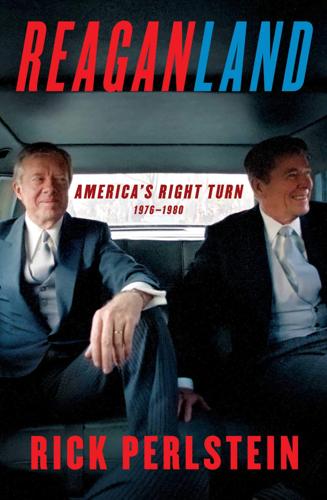
Reaganland: America's Right Turn 1976-1980
by
Rick Perlstein
Published 17 Aug 2020
Reporters expected answers when Carter delivered a major address to hundreds of the nation’s newspaper editors at their annual convention on April 11. He began with a laundry list of reforms to keep inflation in check: a freeze on the pay of executive branch appointees, renegotiation of federal procurement contracts, a promise to veto farm legislation if it looked to increase food prices. He asked Congress to pass his airline deregulation bill to lower the cost of plane tickets (it did so mainly by abolishing the board that sought to guarantee carriers covered all parts of the country, even the less profitable ones), to review the inflationary effect of all pending legislation, and pass a hospital cost containment bill. In a move that must have delighted boardroom Jacobins, he promised to “cut the inflationary costs which private industry bears as a result of government regulations.”
…
The Washington Post called it “the last big poker game of the 95th Congress.” On Friday, October 13, the House passed the natural gas compromise by a single vote. Carter signed a civil service reform bill into law, but Congress had to work past its scheduled adjournment to thread the needle on airline deregulation, transportation funding, bank reform, college aid, veterans’ pensions—and also on the long-suffering energy package. “This day has been a nightmare,” Carter wrote in his diary, noting also the intransigence of Menachem Begin in following through on the agreements reached at Camp David. The next day, the president’s son Chip was confronted by chanting Iranian students protesting the shah.
…
—and then, a few minutes later, an even more passionate avowal that if you loved Franklin Delano Roosevelt, well, maybe Jimmy Carter’s just your man after all: And we believe that we ought to get the Government’s nose out of the private enterprise of this country. We’ve deregulated rail, deregulated trucking, deregulated airlines, deregulated financial institutions, working on communications, to make sure that we have a free enterprise system that’s competitive. Ronald Reagan went on to win New Jersey by almost as much as he did Texas. * * * THE NATION VOTED. OR RATHER, 52.8 percent of eligible voters did—the fewest since 1948, even though the candidates had spent more to woo them than in any election in American history.

Shadow Work: The Unpaid, Unseen Jobs That Fill Your Day
by
Craig Lambert
Published 30 Apr 2015
Air travel boomed after World War II, and by 1950 travel agents handled 70 percent of overseas air reservations. Jet aircraft boosted passenger volume, which ran into the millions. Agents advised customers on passport and visa requirements, currency exchange rates, shopping, sightseeing, weather, and recreation. In 1978, airline deregulation stimulated another surge in business, as airlines and airfares suddenly proliferated to both woo and confuse travelers. Corporate travel expanded, fueling growth. The first global distribution systems (GDS) appeared in 1976. Travel agents use these automated systems to arrange air travel, lodgings, and auto rentals.
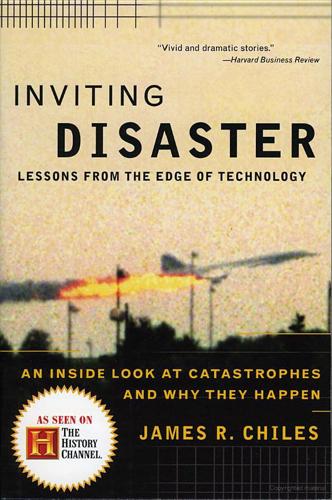
Inviting Disaster
by
James R. Chiles
Published 7 Jul 2008
There was no smoke or flame. Tipped on its right side, the airplane hit the water and raised a mighty plume of mud, vegetation, and shattered limestone. Little’s cell-phone call was the first visual confirmation that ValuJet Flight 592 had gone down. ValuJet was the fast-growing product of federal airline deregulation. ValuJet grew from a two-airplane fleet to fifty-two airplanes in less than three years. ValuJet had started flying DC-9s in 1993. Meanwhile it was adding a new model of airplane, the McDonnell Douglas MD-80 series. ValuJet bought three of them from McDonnell Douglas Finance Corporation in early 1996 and had the airplanes ferried to SabreTech Corporation in Miami, one of its three heavy-maintenance contractors.
…
Citicorp Center (skyscraper): discovery of structural problem New York, New York, United States 1978 Post-construction analysis by building’s engineering consultant indicated that this 914-foot-tall structure was vulnerable to falling over in case of extreme but foreseeable hurricane-force winds coming from diagonal directions. Engineer notified owner, triggering urgent reinforcement of structure before fall hurricane season. Hartford Civic Center Coliseum: collapse of space-frame roof during snowstorm Hartford, Connecticut, United States January 18, 1978 During construction of arena, workers reported that metal structure supporting 300-by-360-foot roof was deflecting 50 percent more than planned and some panels would not fit as designed.
…
GPU started its push by requesting permission to build a single nuclear power plant on Three Mile Island, the name referring to the length of the gravelly bar in the wide Susquehanna River, ten miles down from the state capital of Harrisburg. Unit 1 was completed in 1974. Then GPU wanted another plant. Unit 2, completed in March 1978 and the one headed for infamy, had two cooling towers, a building for fuel storage, a two-hundred-foot-high containment dome to confine leaks from the reactor vessel inside, and two large rectangular buildings for turbines and auxiliary equipment. The cooling towers were one very visible sign that, well before the 1979 crisis, the trends in favor of nuclear power just ten years before were shifting fast.
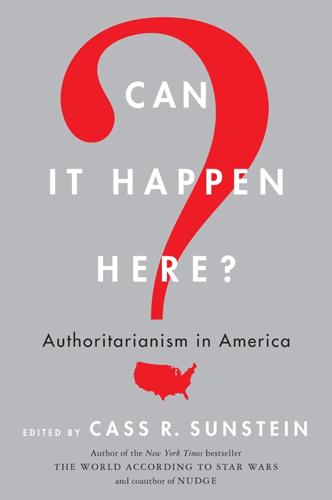
Can It Happen Here?: Authoritarianism in America
by
Cass R. Sunstein
Published 6 Mar 2018
This is all part of a more general process of pacification, feminization, and bureaucratization of just about everything, a process I have outlined in my recent book The Complacent Class: The Self-Defeating Quest for the American Dream. For all the bipartisan agreement that regulatory reform in some manner is needed, very few Western societies have succeeded with it. The biggest example of a deregulatory success in the United States has been airline deregulation, which was done directly by an act of Congress and which abolished the regulating agency, the Civil Aeronautics Board (CAB), outright. This did not have to be done by cutting through a jungle of regulations with the proverbial machete, and the sheer act of outright agency abolition cannot be applied to, say, the Environmental Protection Agency or the Food and Drug Administration, as those institutions perform far too many valuable functions, unlike the CAB.
…
The second problem is that individual choices are often subject to social influence, or what economists call peer effects, meaning that the choice that is most desirable, or simply the most available, to one person depends on what others are doing. Individuals are bound together by complex networks, which can propagate beliefs and behavior in ways that are fundamentally at odds with common sense. In a seminal paper, Mark Granovetter (1978) showed how surprising the dynamics of networked systems can be. Granovetter imagined a hypothetical crowd of agitators on the brink of violence, where each member has some “threshold” for acting out that depends on how many others are. If one member has a threshold of zero, he will trigger without provocation.
…
The Journal of Socio-Economics 33, no. 5 (2004): 587–606. Gilovich, Thomas, Dale Griffin, and Daniel Kahneman, eds. Heuristics and Biases: The Psychology of Intuitive Judgment. Cambridge, UK: Cambridge University Press, 2002. Granovetter, M. S. “Threshold Models of Collective Behavior.” American Journal of Sociology 83, no. 6 (1978): 1420–43. Hardin, Garrett. “The Tragedy of the Commons.” Science 162, no. 3859 (1968): 1243–48. Holmes, Richard. The Age of Wonder: How the Romantic Generation Discovered the Beauty and Terror of Science. New York: Vintage Books USA, 2010. Imbens, Guido W., and Donald B. Rubin. Causal Inferences in Statistics, Social, and Biomedical Science.
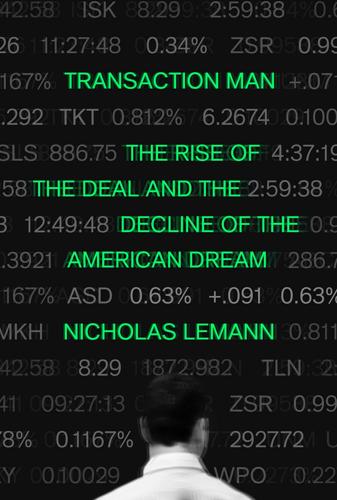
Transaction Man: The Rise of the Deal and the Decline of the American Dream
by
Nicholas Lemann
Published 9 Sep 2019
“When the laws undertake”: Andrew Jackson’s veto message of the Second Bank of the United States, July 10, 1832. http://avalon.law.yale.edu/19th_century/ajveto01.asp. In 1975 the country’s leading liberal politician: Stephen Breyer gives a full account of airline deregulation in Regulation and Its Reform, Harvard University Press, 1982. “sheer perversity”: Robert Bork, The Antitrust Paradox: A Policy at War with Itself, The Free Press, 1978, 185. “a land in which women”: Edward M. Kennedy, speech opposing the nomination of Robert Bork to the Supreme Court of the United States, July 1, 1987. Congressional Record, Senate, July 1, 1987, 18518. Milken also developed a client base: The 269-page brief by the celebrated trial lawyer David Boies in the case of FDIC v.
…
Kennedy assembled an ideologically diverse array of supporters of deregulation, including Nader and Milton Friedman; the main opponents were the airlines themselves and their labor unions. In 1978 the first Democratic president of the 1970s, Jimmy Carter, signed legislation abolishing the CAB entirely. Carter also deregulated trucking and railroads, and he signed the first of a series of major laws deregulating finance—giving banks, in the name of serving the consumer, the ability to pay much higher interest rates to their depositors. In 1978 Robert Bork, a protégé of Aaron Director’s at the University of Chicago Law School and a Republican law professor and government official, published The Antitrust Paradox, which argued that the only acceptable rationale for government regulation of the economy was consumer welfare.
…
He had a new solution, which was to remake boards of directors so that they were composed of principals (that is, major shareholders) rather than agents (distinguished-seeming cronies of the chief executive). But the truth was, he had now departed in a profound way from the core idea that financial markets are a healthy force because they always set prices efficiently. Back in 1978, in the introduction to a special issue of the Journal of Financial Economics devoted to his friend Eugene Fama’s efficient market hypothesis, Jensen wrote, “In the literature of finance, accounting, and the economics of uncertainty, the Efficient Market Hypothesis is accepted as a fact of life, and a scholar who purports to model behavior in a manner which violates it faces a difficult task of justification.”
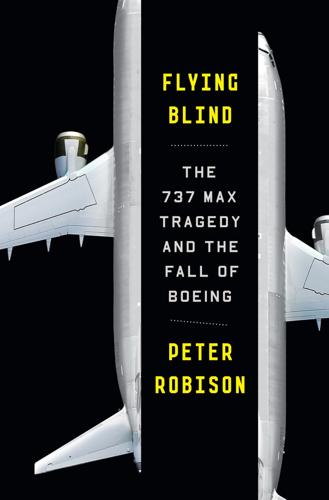
Flying Blind: The 737 MAX Tragedy and the Fall of Boeing
by
Peter Robison
Published 29 Nov 2021
Borman, he recalls, immediately “went to the White House and bled all over them”—telling Vice President Walter Mondale that his airline would have to cut jobs if it couldn’t buy the planes. Foreign policy considerations also argued against a trade fight with European allies in the midst of the Cold War. Carter let Airbus in. That same year, his administration pushed for passage of the Airline Deregulation Act, eliminating the government agency that had, since 1938, been responsible for setting minimum airfares. Prices at the time were soaring, and the Civil Aeronautics Board was painted as the culprit, a corrupt agency doing the airlines’ bidding to keep fares inflated. The new legislation meant that the country’s airlines would be run like the post office no more.
…
The group, known as Speea, saw itself as more of a professional association than a traditional labor union; its first priority was eliminating a collusionary practice under which rival aerospace companies gave notice before hiring each other’s employees. Long after he’d risen to become CEO, Wilson kept up a regular bridge game with his old Speea friends. The Boeing chief was well paid, one of a dozen industrial executives in the country who earned more than $1 million in 1978. (Adjusted for inflation, his pay was equivalent to $5 million in 2019—less than a quarter of the average CEO compensation of $21.3 million that year.) But Wilson had little use for the trappings of corporate leadership, driving himself to work in a Chevrolet Camaro and living in the same house in a nondescript Seattle suburb that he and his wife had bought thirty years earlier.
…
The European consortium approached the market with messianic intent. “We are fighting for our children,” then Airbus chief Bernard Lathiere said in 1975. “If we don’t have a place in high technology in Europe, we should be slaves to the Americans and our children will be slaves. We have to sell…we must fight and fight.” Airbus clinched its first U.S. order in 1978, when Florida-based Eastern Airlines bought twenty-three twin-engine A300s. It was, as the New York Times declared, “the biggest foreign penetration ever made in the American market for airliners.” Eastern chief Frank Borman, the astronaut who’d commanded the Apollo 8 moon mission, told a reporter the value was equal to “less than four and a half days of imports of Japanese cars.”
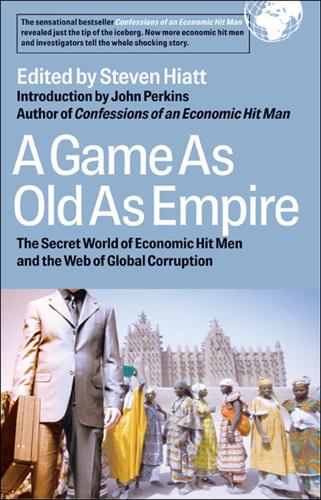
A Game as Old as Empire: The Secret World of Economic Hit Men and the Web of Global Corruption
by
Steven Hiatt; John Perkins
Published 1 Jan 2006
The next step was to build political infrastructure on both sides of the newly parted Iron Curtain. To chair ITIC jointly, they selected John Robson and Lord Peter Walker. Robson, a lawyer who had been head of the Civil Aeronautics Board in the 1970s, was renowned for his toughness and his role as an architect of airline deregulation. Subsequently, he became a protégé of Donald Rumsfeld at the Searle pharmaceutical company before joining George Bush Sr.’s administration as deputy secretary of the treasury. Peter Walker also knew how to be tough. As energy secretary under Prime Minister Margaret Thatcher, he had taken on—and beaten—the National Union of Mineworkers.
…
Those Americans, like Americans everywhere, are just beginning to realize that their money is no longer being used to build the house next door. I used to sell their money for a living. I used to travel the world for a medium-sized Midwestern bank with $5 billion in assets. Along the way, I was engaged in some of the startling “business as usual” banking practices that have begun to plague the world financial system. • • • It is 1978. Thanks to the venal, repressive regime of President Ferdinand Marcos of the Philippines, I am safely and happily roosting in one of Manila’s best hotels, the Peninsula. I am about to set in motion a peculiar and idiosyncratic process that will result in a $10 million loan to a Philippine construction company, a bedfellow of the Marcos clan—a loan that will soon go sour.
…
The Bank of England was charged with oversight for fifteen years, and it said that everything was just fine. By 1977, BCCI had 146 branches in forty-three countries. Its assets rose from $200 million to $2.2 billion. Bank of America smelled a rat because of the poor documentation of loans, and it bailed out in 1978—but without raising any alarms in the U.S. Warnings might have depressed the stock, which BofA sold at a profit, turning a $2.5 million investment into $34 million. Silence was indeed golden. By 1983, BCCI had 360 offices in sixty-eight countries: 91 in Europe; 52 in the Americas; 47 in the Far East, South Asia, and Southeast Asia; 90 in the Middle East; and 80 in Africa.

Evil Geniuses: The Unmaking of America: A Recent History
by
Kurt Andersen
Published 14 Sep 2020
Airlines had their own government-protected quasi-monopolies that let them charge high prices that virtually guaranteed high profits. The rigmarole required to adjust fares up or down or change routes was the opposite of nimble. Starting a new airline was nearly impossible. So who finally made airline deregulation happen in the late 1970s? Famous liberals, Senator Ted Kennedy and his aide Stephen Breyer, the future Supreme Court justice, in order to make the carriers really compete on price and service. Airline fares dropped, and new, better airlines got started.*4 It was also the Democratic president and Congress in the late 1970s that phased out the old government-set prices for natural gas and shipping freight on railroads.
…
A critical mass of the people elected to run the government had also been persuaded to give big business what it wanted. Democrats held the presidency and a two-to-one House majority and a historic sixty-two-seat Senate majority. Yet in early 1978, a bill to create a new consumer protection agency was defeated in the House because 101 Democrats voted against it, including a majority of the Democratic freshmen, thanks in large part to lobbying by CEOs from the Business Roundtable. And 1978 was also a tipping-point year in the economic right’s crusade to persuade people that because government now sucked, all taxes paid to all governments by everyone, no matter how wealthy, were way too high and also sucked.
…
They were encouraged by a culture industry that immediately created a wide-ranging nostalgia division of a kind that hadn’t existed before. The Last Picture Show, set in 1951, came out in 1971, made tons of money, and won Oscars. The musical Grease, set in 1959, appeared in 1971, became the most popular movie of 1978 (featuring Sha Na Na, who by then had their own popular TV variety show), and ran on Broadway for the whole decade. The Way We Were, the fifth most popular movie of 1973, was set mainly in the 1950s. George Lucas’s American Graffiti, set in 1962, was the third most popular movie of 1973 and softened the ground for the premiere a few months later of its TV doppelgänger Happy Days, which in 1976 spun off Laverne & Shirley, set in the late 1950s and early ’60s.
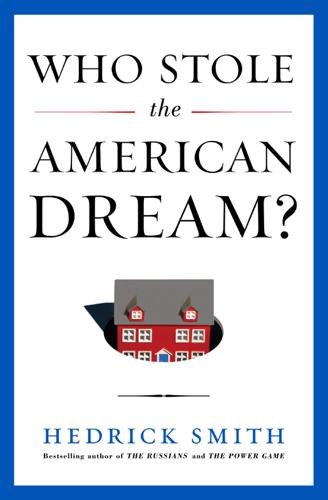
Who Stole the American Dream?
by
Hedrick Smith
Published 10 Sep 2012
Bureau of Labor Statistics, “B-2: Average Hours and Earnings of Production and Nonsupervisory Workers on Private Nonfarm Payrolls by Major Industry Sector, 1964 to Date,” http://www.bls.gov/ces/#tables. 12 The first priority “Congress Clears Trucking Deregulation Bill,” CQ Almanac 1980 (Washington, DC: Congressional Quarterly, 1981); “Congress Clears Airline Deregulation Bill,” CQ Almanac 1978 (Washington, DC: Congressional Quarterly, 1979); “House, Senate Advance Bills to Curb FTC,” CQ Almanac 1979 (Washington, DC: Congressional Quarterly, 1980). 13 The first major bankruptcy reform Lynn M. LoPucki and William C. Whitford, “Corporate Governance in the Bankruptcy Reorganization of Large, Publicly Held Companies,” University of Pennsylvania Law Review 141, no. 3 (January 1993): 674–75, 688–92, 719; Robert Lawless, email, January 6, 2012. 14 Labor union contracts Lawless, email, December 21, 2011. 15 Banks got top priority “Congress Approves New Bankruptcy System,” CQ Almanac 1978 (Washington, DC: Congressional Quarterly, 1979), 179–82. 16 “A big part of the selling” Elizabeth Warren, interview, February 6, 2006. 17 Instead of tax increases “Congress Preparing Tax Lop-offs: Capital Gains, Retired Get Biggest Relief,” Associated Press, October 15, 1978; How Capital Gains Tax Rates Affect Revenues: The Historical Evidence (Washington, DC: Congressional Budget Office, March 1988), 34, http://www.cbo.gov. 18 “Business began to see” Arthur Levitt, interview, April 20, 1986.
…
The Pivotal Year—1978 But the corporate political rebellion was intent on more than blocking its opponents. Business was bent on gains of its own. In 1978, the corporate political machine went on the offensive and achieved a legislative agenda that would have profound and far-reaching impact. Over the next couple of decades, it would dramatically affect the standard of living of tens of millions of middle-class Americans and the American middle-class dream of winning a fair share of the prosperity generated by the nation’s economic growth. Virtually every economic bill that passed in 1978 had a policy tilt in favor of business and the wealthy, often at the expense of the middle class, even if that impact was not immediately apparent.
…
CHAPTER 2: THE PIVOTAL CONGRESS 1 “Fifteen years ago, the businessman” “The Swarming Lobbyists: Washington’s New Billion-Dollar Game of Who Can Influence Whom,” Time, August 7, 1978, 14. 2 “Business’s new lobbying weapon” “A Potent New Business Lobby,” Business Week, May 22, 1978. 3 The decisive force “The Swarming Lobbyists.” 4 “Never seen such extensive lobbying” “Carter Dealt Major Defeat on Consumer Bill,” CQ Almanac 1978 (Washington, DC: Congressional Quarterly, 1979). 5 A disastrous defeat Hacker and Pierson, Winner-Take-All Politics, 126–27. 6 Council on Union-Free Environment “Council Is Formed by NAM for Union-Free Environment,” The Washington Post, December 2, 1977. 7 It passed the House “House Passes Bill Aiding Union Drives,” The New York Times, October 7, 1977. 8 “What the filibuster does” Ray Marshall, interview, June 14, 2011. 9 Douglas Fraser … resigned Jefferson Cowie, “ ‘A One-Sided Class War’: Rethinking Doug Fraser’s 1978 Resignation from the Labor-Management Group,” Labor History 44, no. 3 (2003): 307–14. 10 Some wins for labor “Carter Signs Minimum Wage Bill, Giving Raises of 45 Percent by ’81,” The New York Times, November 2, 1977. 11 Federal minimum wage fell U.S.

More: The 10,000-Year Rise of the World Economy
by
Philip Coggan
Published 6 Feb 2020
Shirley Temple, the Hollywood child star, was the first passenger to buy a sleeping ticket on a flight.52 Early airlines realised what Thomas Petzinger dubbed the “first rule of airline economics”: if a plane is going to take off anyway, any extra payload in the form of passengers or goods is almost pure profit.53 In the early years of commercial aviation, flying was seen as a glamorous business. People would dress up to go on a flight. But only the well-off could afford it. All this changed significantly in the 1970s. Jimmy Carter signed the Airline Deregulation Act in 1978, bringing to an end a four-decade period in which routes and fares had been tightly controlled by the US government. In 1960, US airlines carried 62 million passengers; by 2017, they carried almost a billion.54 The first British package holiday was created in 1950 by a Russian émigré called Vladimir Raitz, who offered tourists a six-hour journey (including a refuelling stop) to a campsite in Corsica.55 In the 1960s, Clarksons introduced cheap flights to Spain, spurring the huge development of the Costa Blanca.
…
Farmers still had to hand over a proportion of their output to the state but they were allowed to sell the rest and limits on prices were lifted. There was some inflation but the effect on food output was spectacular. Yields rose by 40% per acre and rural incomes rose by 18% a year between 1978 and 1984.3 Farmers also started to plant different crops, like rapeseed and sugar cane, which party commissars had frowned upon. With a greater incentive to produce more, farmers also bought more equipment; the number of agricultural trucks rose from 74,000 in 1978 to more than 600,000 by the end of the 1980s.4 A growth miracle China, GDP per person, annual growth, % Source: World Bank There followed a wave of reforms that were, in part, an experiment to see what worked and, in part, an attempt to reward local initiative.
…
Many people use the word neoliberal for this trend, but its definition is fairly vague, and it has become a catch-all term of abuse. 2. Jones, Multinationals and Global Capitalism, op. cit. 3. Max Roser, “Life expectancy”, Our World in Data, https://ourworldindata.org/life-expectancy 4. Laurel Graefe, “Oil shock of 1978–79”, https://www.federalreservehistory.org/essays/oil_shock_of_1978_79 5. Ibid. 6. Source: https://www.nber.org/cycles.html 7. J.-P. Fitoussi and E.S. Phelps, “Causes of the 1980s slump in Europe”, https://core.ac.uk/download/pdf/6252244.pdf 8. Olivier Blanchard and Lawrence Summers, “Hysteresis and the European unemployment problem”, https://www.nber.org/chapters/c4245.pdf 9.
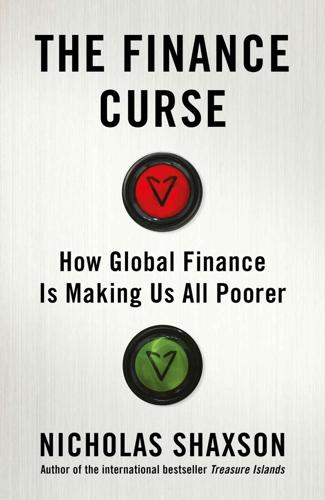
The Finance Curse: How Global Finance Is Making Us All Poorer
by
Nicholas Shaxson
Published 10 Oct 2018
On South Africa, see ‘HIV drugs boost South African life expectancy’, BBC News, 1 August 2004; Linda Nordling, ‘South Africa ushers in new era for HIV’, Nature, 13 July 2016; Sarah Boseley, ‘Big Pharma’s Worst Nightmare’, Guardian, 26 January 2016; and ‘SA drops price of ARVs, saves R11bn in six years’, timeslive.co.za, 22 September 2017. 26. The changes included the Airline Deregulation Act of 1978, the Depository Institutions Deregulation and Monetary Control Act of 1980, the Staggers Railroad Act of 1980 and especially the 1982 Merger Guidelines under the Reagan administration, which explicitly cited ‘efficiency’ and ‘consumer welfare’ as the only legitimate goals of antitrust. 27.
…
Bork’s idea that predatory pricing didn’t exist was based on mathematical modelling which suggested that predators would have to spend too much on loss-making strategies to make those losses worthwhile. He credited Director with some of these insights (see for instance Robert H. Bork and Ward S. Bowman Junior, ‘The Crisis in Antitrust’, Fortune, December 1963), which laid out some of the arguments that would emerge in Bork’s Antitrust Paradox, Basic Books, 1978. Both the Fortune article and the 1978 book include extraordinary displays of magical reasoning. The Fortune article, for instance, includes the sentence: ‘Professor John McGee, an economist now at Duke University, reviewed the entire case record of the Standard Oil litigation and reported that there is not one clear episode of the successful use by Standard Oil of local price cutting or other predatory practices.’
…
Years later Senator Edward Kennedy would denounce him in these terms: Robert Bork’s America is a land in which women would be forced into back-alley abortions, blacks would sit at segregated lunch counters, rogue police could break down citizens’ doors in midnight raids, schoolchildren could not be taught about evolution, writers and artists would be censored at the whim of government, and the doors of the federal courts would be shut on the fingers of millions of citizens for whom the judiciary is often the only protector of the individual rights that are the heart of our democracy.12 Bork denied these charges and his record was more nuanced than Kennedy’s picture suggests, but there is no doubting it: Robert Bork was a scary piece of work. Bork’s singular – and colossal – contribution to the game at hand was a little firecracker of a book published in 1978 called The Antitrust Paradox. This built on work by Richard Posner and went even further than Coase, decisively shifting the focus of antitrust law beyond Coase’s focus on ‘efficiency’ to something simpler to understand: prices for consumers. ‘The only legitimate goal of American antitrust law,’ he said, ‘is the maximisation of consumer welfare.’

Capitalism in America: A History
by
Adrian Wooldridge
and
Alan Greenspan
Published 15 Oct 2018
The restructuring of corporate America generated a hard core of companies that could compete effectively on the international playing field. GE and Intel were as good as any companies in the world. Deregulation created big opportunities for businesses of all kinds. The deregulation of the airport sector created space for innovators such as Southwest Airlines. Deregulation in general speeded the diffusion of new technologies. The breakup of AT&T’s monopoly of the telecom industry in 1982 spurred both a reduction in prices and a surge of innovation. The deregulation of transportation helped to produce a logistics revolution that reduced the cost of inputs into the economy.
…
One of his earliest franchisees, Jim Delligatti, came up with the idea for a Big Mac in 1967. Kemmons Wilson opened his first Holiday Inn in 1952 with all the modern conveniences (a TV and swimming pool) and no extra charge for children. Richard and Henry Bloch started franchising their tax-preparation business in 1955. By 1978, H&R Block was completing one in nine tax returns annually.30 CORPORATE IMPERIALISM Confident, professional, and innovative, American companies expanded abroad at an unprecedented rate: their collective investment in Europe and Japan increased from $2 billion in 1950 to $41 billion in 1973.
…
By the end of the 1970s, it looked as if the world’s most powerful economy had forgotten how to achieve the most basic form of economic management—stable prices. Stagflation created political convulsions. Workers agitated for higher pay raises to keep up with the rising cost of living. Savers were upset as they saw their life savings destroyed. Taxpayers revolted as rising nominal incomes brought them into higher tax brackets. In 1978, furious that they were paying ever-higher property taxes while the services they got for their taxes were either stagnant or deteriorating, the sprawling suburbs of Southern California had had enough. Led by Howard Jarvis, an energetic antitax protester, Californians passed Proposition 13, halving their property taxes at a stroke and making it all but impossible to raise property taxes in the future.

Cockpit Confidential: Everything You Need to Know About Air Travel: Questions, Answers, and Reflections
by
Patrick Smith
Published 6 May 2013
To be impartial, I might mention the knee-breaking seat pitch and treacherous cuisine of EgyptAir and Royal Air Maroc, but exceptions like these are uncommon. How we got to such a shameful position is the subject of debate. Is it a fiscal thing? A cultural thing? A little of both? It has been a long, hard slide, and most folks agree that it began at or around the moment president Jimmy Carter attached his signature to the Airline Deregulation Act of 1979. From that moment on it was a race to the bottom, with competitive chaos inspiring a battle so fierce that, from the airlines’ perspectives, undercutting the competition became more important than pleasing customers. By 2001, the few remaining extravagances were curtailed in the battening-down that began after September 11.
…
Linked into the cockpit transponder, Traffic Collision Avoidance System (TCAS, pronounced Tea-Cass), gives pilots a graphic, on-screen representation of nearby aircraft. If certain thresholds of distance and altitudes are crossed, TCAS will issue progressively ominous oral and visual commands. If two aircraft continue flying toward each other, their units work together, vocalizing a loudly imperative “CLIMB!” instruction to one and “DESCEND!” to the other. In 1978, a Pacific Southwest Airlines 727 collided with a Cessna while preparing to land at San Diego. In 1986, an Aeromexico DC-9 plunged into a Los Angeles suburb after hitting a Piper that had strayed, sans permission, into restricted airspace. Ten years later, a Saudi Arabian 747 was struck by a Kazakh cargo jet over India.

Power and Progress: Our Thousand-Year Struggle Over Technology and Prosperity
by
Daron Acemoglu
and
Simon Johnson
Published 15 May 2023
For example, the airline industry was tightly regulated by the Civil Aeronautics Board during much of this time. The board set schedules, routes, and airline fares, and decided which new airlines could enter new markets. As civil aviation technology improved and demand for air travel grew, these regulations became more arcane and contributed to massive inefficiencies in the industry. The Airline Deregulation Act of 1978 allowed airlines themselves to set fares. This made it easier for new airlines to enter the market, increasing competition and driving down prices in ways that were generally welcomed by consumers. On the Side of Angels and Shareholders The idea that unregulated markets work in the interest of the nation and the common good became the basis for a new approach to public policy.
…
OECD Working Paper no. 5, www.oecd-ilibrary.org/economics/the-best-versus-the-rest_63629cc9-en. Appelbaum, Binyamin. 2019. Economists’ Hour: False Prophets, Free Markets, and the Fracture of Society. New York: Little, Brown. Applebaum, Anne. 2017. Red Famine: Stalin’s War on Ukraine. New York: Doubleday. Arendt, Hannah. 1978. “Totalitarianism: Interview with Roger Errera.” New York Review of Books, www.nybooks.com/articles/1978/10/26/hannah-arendt-from-an-interview. Arrow, Kenneth J. 1962. “The Economic Implications of Learning by Doing.” Review of Economic Studies 29:155‒173. Ash, Elliott, Daniel L. Chen, and Suresh Naidu. 2022. “Ideas Have Consequences: The Impact of Law and Economics on American Justice.”
…
The Future of Work: Robots, AI and Automation. Washington: Brookings Institution. White, Lynn Jr. 1964. Medieval Technology and Social Change. New York: Oxford University Press. White, Lynn Jr. 1978. Medieval Religion and Technology: Collected Essays. Berkeley: University of California Press. Wickham, Christopher. 2016. Medieval Europe. New Haven, CT: Yale University Press. Wiener, Jonathan M. 1978. Social Origins of the New South: Alabama, 1860‒1885. Baton Rouge: Louisiana State University Press. Wiener, Norbert. 1949. “The Machine Age.” Version 3. Unpublished paper, Massachusetts Institute of Technology. https://libraries.mit.edu/app/dissemination/DIPonline/MC0022/MC0022_Machine AgeV3_1949.pdf.
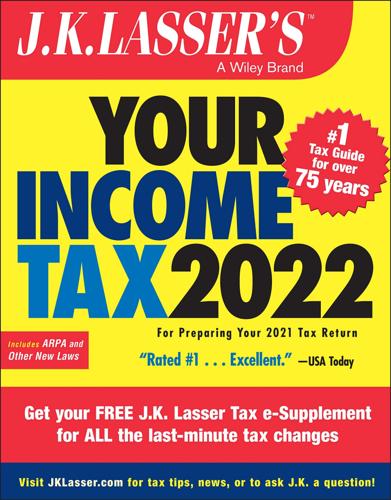
J.K. Lasser's Your Income Tax 2022: For Preparing Your 2021 Tax Return
by
J. K. Lasser Institute
Published 21 Dec 2021
Unemployment benefits from a private or union fund to which you voluntarily contribute dues are reportable as “other” income on Schedule 1 (Form 1040 or 1040-SR), but only to the extent the benefits exceed your contributions to the fund. Your contributions to the fund are not deductible. Workers’ compensation payments (2.13) are not taxable. Taxable unemployment benefits include federal trade readjustment allowances (1974 Trade Act), airline deregulation benefits (1978 Airline Deregulation Act), and disaster unemployment assistance (1974 Disaster Relief Act). Repaid supplemental unemployment benefits. If you had to repay supplemental unemployment benefits to receive trade readjustment allowances (1974 Trade Act), taxable unemployment benefits are reduced by repayments made in the same year.
…
See Applicable federal rate After-tax retirement contributions, 180, 182 Age 18 (children under), 515–16 Age 30 duration rule, 629 Age 50 (persons at or over), 216 Age 59½ (persons under), 182, 190–92, 196, 235–39, 254 Age 65 (persons over), 2, 351, 353–54 Age 70½ (persons over), 188, 216–19, 228–29 Age 72 (persons over), 188, 240, 729 Age limit, IRA contribution, 216–18, 255 Age test, 484 Aggregate treatment of activities, 294, 296–97, 707 AGI. See Adjusted gross income Agreements. See specific types Airline Deregulation Act, 43 Airplanes, 70, 368–69 Aliens dual-status, 30, 31–32, 352 nonresident, 16, 29–30, 169, 525, 638, 645, 783 resident, 30–33 Alimony, 670–75, 1015 child support payments vs., 674 as compensation, 214 death of payee-spouse and, 673–74 decree/agreement required for, 672 deduction for, 347 and legal fees of marital settlements, 675 minimum payment period for, 675 payments of, 671–74 rules for post-2018 agreements, 671 rules for pre-2019 agreements, 671 Allocation reporting of tips, 542 Alternative depreciation system (ADS), 745 Alternative fuel vehicle refueling property credit, 719 Alternative minimum tax (AMT), 500–507, 678, 1015 2020 rules for, 501 adjustments and preferences for, 503–6 avoiding, 507 depreciation, 746 exemptions and tax brackets, xxix on Form 6251, 502–3 and intangible drilling costs, 283 interest on tax-exempt securities and, 587–88 ISOs and, 51 kiddie tax and, 510 for private activity bonds, 102 recovered deductions and, 324–25 regular income tax liability and, 496 state tax refunds and, 321 tax credit for prior-year, 506 tax credits against, 506 and tax rate, 12 Alternative motor vehicle credit, 719 Amended returns, 1015 additional taxes for, 798, 801 to claim reduced maximum exclusion, 569 filing, 796 Amended U.S.
…
Wittstruck, 645 F.2d 618 (8th Cir. 1981), aff'g per curiam 39 TCM 1168 (1980) Temporary rental preceding sale Stephen Bolaris, 776 F.2d 1428 (9th Cir. 1985), rev'g 81 TC 840 (1983) Profit motive Robert I. Redisch, TC Memo 2015-95 IRC §183 Terence D. Clancy, 37 TCM 400 (1978) Marvin Eisenstein, 37 TCM 441 (1978) Truett E. Allen, 72 TC 28 (1979) (Acq.) Lester W. Lindow, 37 TCM 1257 (1978) Richard H. Nelson, 37 TCM 1204 (1978) Mark M. Vandeyacht, 62 TCM 2606 (1994) 9.11 REPORTING ROYALTY INCOME License fees for use of patented article Reg. §1.61-8(a) Renting fees Reg. §1.61-8(a) Author's royalties Reg. §1.61-8(a) Rev. Rul. 60-31, 1960-1 CB 174, modified by Rev.
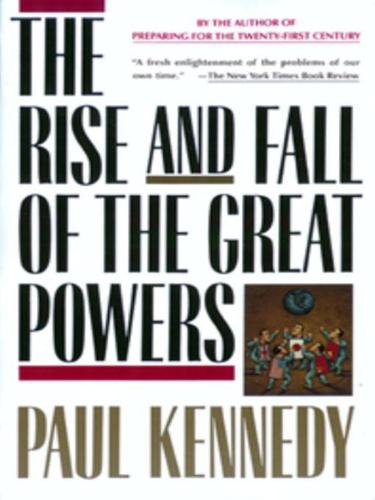
The Rise and Fall of the Great Powers: Economic Change and Military Conflict From 1500 to 2000
by
Paul Kennedy
Published 15 Jan 1989
Although the coordination of currencies is now more successful than it was, the occasional realignments which do take place (usually involving a revaluation of the German mark) are a reminder of the separate fiscal systems—and differentiated credit-worthiness—of the members. Despite proposals from the European Commission, there is as yet little progress toward a common European policy on a whole variety of issues, from full-scale airline deregulation to financial services. At too many of the common frontiers there are still customs posts, and lengthy checks, to the fury of the truck drivers. Even agriculture, the mainstay of the EEC’s spending functions and one of the few economic sectors where there is a “common market,” has proved to be a bone of contention.
…
Keylor, Twentieth-Century World, pp. 354ff, 408ff; A. Bronke and D. Novak (eds.), The Communist States in the Era of Detente, 1971–1977 (Oakville, Ont., 1979); R. L. Tokes, Euro-Communism and Detente (New York, 1978); G. B. Ginsburgs and A. Z. Rubinstein (eds.), Soviet Foreign Policy Towards Western Europe (New York, 1978); L. L. Whetten, Germany’s Ostpolitik (London, 1971); and W. E. Griffith, The Ostpolitik of the Federal Republic of Germany (Cambridge, Mass., 1978), cover the German aspects. 165. H. Salisbury, The Coming War Between Russia and China (London, 1969), passim. 166. Some of these concerns are discussed in E. Morton and G.
…
Kennan, American Diplomacy (Chicago, 1984 edn.), chs. 1–3; and Dallek, American Style of Foreign Policy, passim. 169. U.S. naval growth and naval policy in this period are now very well covered. Apart from Potter (ed.), Sea Power, chs. 15 and 17–18, see K. J. Hagan (ed.), In Peace and War: Interpretations of American Naval History, 1775–1978 (West-port, Conn., 1978), chs. 9–10; W. R. Braisted, The United States Navy in the Pacific, 2 vols. (Austin, Texas, 1958 and 1971); and the older works H. and M. Sprout, The Rise of American Naval Power, 1776–1918 (Princeton, N.J., 1946 edn.), and W. Mills, Arms and Men (New York, 1956), ch. 2. 170. Apart from Braisted’s important works, see R.
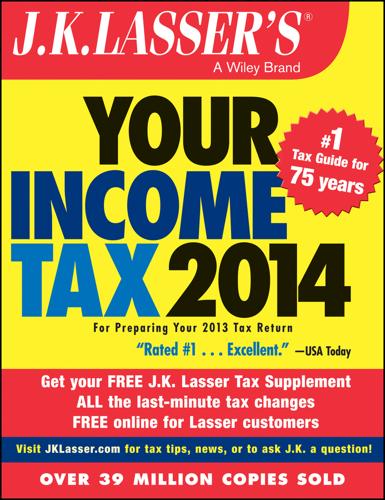
J.K. Lasser's Your Income Tax 2014
by
J. K. Lasser
Published 5 Oct 2013
Unemployment benefits from a private or union fund to which you voluntarily contribute dues are taxable as “other” income on Form 1040, but only to the extent the benefits exceed your contributions to the fund. Your contributions to the fund are not deductible. Workers’ compensation payments (2.13) are not taxable. Taxable unemployment benefits include federal trade readjustment allowances (1974 Trade Act), airline deregulation benefits (1978 Airline Deregulation Act), and disaster unemployment assistance (1974 Disaster Relief Act). Repaid supplemental unemployment benefits If you had to repay supplemental unemployment benefits to receive trade readjustment allowances (1974 Trade Act), taxable unemployment benefits are reduced by repayments made in the same year.
…
See Alternative depreciation system Advance payments Advance rentals Advances, against commissions Advance valuation of art AFR. See Applicable federal rate Age 30 duration rule Age 591/2 (persons under) Age 65 (persons over) Age 701/2 (persons over) Age test Aggregate treatment of activities AGI. See Adjusted gross income Agreements. See specific types Aides (school) Air Force Academy Airline Deregulation Act (1978) Airline pilots Airplanes Aliens. See Nonresident aliens; See Resident aliens Alimony 3rd year recapture for drops in cash payments of child support payments vs. death of payee-spouse and minimum payment period for payments taxable, as compensation Allowable Credit for 2012 Alternative depreciation system (ADS) Alternative minimum tax (AMT) adjustments and preferences for avoiding depreciation on Form 6251 and intangible drilling costs interest on tax-exempt securities and ISOs and kiddie tax and miscellaneous deductions for private activity bonds recovered deductions and state tax refunds and tax credit from regular tax tax credits against and tax rate Alternative trade adjustment assistance (ATAA) program Amended returns Amended U.S.
…
You might be given the right to buy the deceased person’s property under his or her will. This is not the same as inheriting that property. Your basis is what you pay—not what the property is worth on the date of the deceased’s death. If property was inherited from an individual who died after 1976 and before November 7, 1978, and the executor elected to apply a carryover basis to all estate property, your basis is figured with reference to the decedent’s basis. The executor must inform you of the basis of such property. Community property Upon the death of a spouse in a community property state, one-half of the fair market value of the community property is generally included in the deceased spouse’s estate for estate tax purposes.
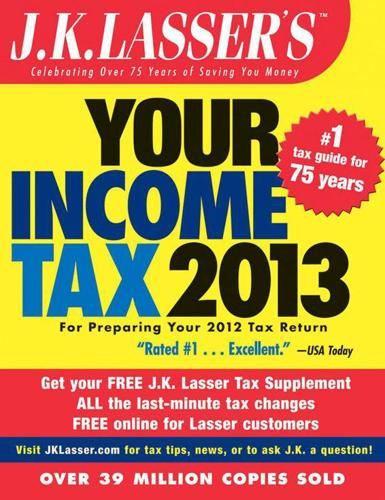
J.K. Lasser's Your Income Tax
by
J K Lasser Institute
Published 30 Oct 2012
Unemployment benefits from a private or union fund to which you voluntarily contribute dues are taxable as “other” income on Form 1040, but only to the extent the benefits exceed your contributions to the fund. Your contributions to the fund are not deductible. Workers’ compensation payments (2.13) are not taxable. Taxable unemployment benefits include federal trade readjustment allowances (1974 Trade Act), airline deregulation benefits (1978 Airline Deregulation Act), and disaster unemployment assistance (1974 Disaster Relief Act). Repaid supplemental unemployment benefits. If you had to repay supplemental unemployment benefits to receive trade readjustment allowances (1974 Trade Act), taxable unemployment benefits are reduced by repayments made in the same year.
…
Index Numerics 0% rate on capital gains 2% AGI (adjusted gross income) floor deductions, effect of job expenses not subject to job expenses subject to miscellaneous itemized deduction subject to moving expenses not subject to 15% rate on capital gains 28% capital rate gains from sales 30% adjusted gross income ceiling 30-day disbursement rule on loan proceeds 50% ceiling on charitable contributions 65 in age and over, tax benefits for 183-day substantial presence test for resident aliens 401(k) plans corrective distributions from elective deferral limit hardship withdrawals from limit on salary reduction deferrals nondiscrimination rules one-person 401(k) plan ordinary income, taxed as partnership plans restrictions on withdrawals Roth 401(k) contributions SIMPLE IRA, contribution to both SIMPLE plans tax benefits of tax-favored retirement plan, key to withdrawals before age 59½ withholdings for retirement plans 403(b) plans, annuities for employees of tax-exempts and schools nonspousal beneficiaries rollover from employer plan to Roth IRA Roth contributions to 2010 healthcare reform legislation A Abandoned securities Abandonments of property Abode test for qualifying children as exemption Abstract of title fees Accelerated cost recovery system (ACRS) Accelerated death benefits Accountable reimbursement plan Accountants employer-provided material participation tests travel costs Accrual basis accounting for business income Accrual method of accounting Accumulated earnings and profits Acknowledgment, written, for charity contributions Acquisition debt Acquisition premium Active participation in employer plan Adequate accounting, importance of Adjusted basis for casualty losses how to find of sale of home Adjusted gross income (AGI) 2% AGI floor 7.5% AGI floor on itemized deductions for medical costs 10% AGI floor, on losses to personal-use property deductions allowed in figuring excess figuring hobby expenses lottery and sweepstakes winnings medical expenses no phaseout of itemized deductions for 2012 reporting child’s income on your return Roth IRA contributions Adopted children adoption credit benefit as fringe benefit expenses, employer-provided assistance, MAGI and medical expenses of not a U.S. citizen or resident, exemption for qualified adoption expenses relationship test for claiming an exemption scholarship for, not a support item Ad valorem tax Advance lean burn credits Advance payment accounting method for reporting business income health coverage credit song publishers to composers, amortizing song rights time limits for receiving Advances, against unearned commissions Airfares, subject to 2% AGI floor Airline deregulation benefits Airline employees free or low-cost flights provided to IRS meal allowance pilot Airplane company plane depreciate business property donated, substantiation rules for fuel-related credits Alaska, IRS meal allowance for travel in Aliens dual tax status expatriation tax in first year of residency in last year of residency leaving U.S.
…
You might be given the right to buy the deceased person’s property under his or her will. This is not the same as inheriting that property. Your basis is what you pay—not what the property is worth on the date of the deceased’s death. If property was inherited from an individual who died after 1976 and before November 7, 1978, and the executor elected to apply a carryover basis to all estate property, your basis is figured with reference to the decedent’s basis. The executor must inform you of the basis of such property. Community property. Upon the death of a spouse in a community property state, one-half of the fair market value of the community property is generally included in the deceased spouse’s estate for estate tax purposes.

The Rise and Fall of American Growth: The U.S. Standard of Living Since the Civil War (The Princeton Economic History of the Western World)
by
Robert J. Gordon
Published 12 Jan 2016
These three incidents with their very different causes—inadequate air traffic control, faulty maintenance, and pilot error—appear to have taught airlines and aircraft manufacturers many lessons. To quote the title of Ralph Nader’s famous book, air travel was initially “unsafe at any speed” but now is safer than walking across the street. AIRLINE PRICES AND THE INITIAL PROMISE OF AIRLINE DEREGULATION In the history of the U.S. airline industry since World War II, one theme stands out. Air travel rapidly made the transition from a travel mode that was relatively dangerous and expensive to one that opened the world as an affordable destination for millions of Americans. In the words of the epigraph that opens this chapter, air travel “lifted from the human race the curse of distance.”
…
College professors who are engaged in research and writing travel many times each year to annual meetings of the national association in their field, and they present and discuss papers at numerous conferences and at invited seminars at other universities. If the speed and comfort of jet travel have not changed since the 1960s, then what has changed? The most important event of the jet age for domestic U.S. air travel was the deregulation of the airline industry, achieved in 1978 after decades of controversy. Until 1978, airlines could not fly where they wanted to fly and could not choose the price they charged to passengers. To take the case of Chicago, only United and Northwest could take passengers from Chicago to Seattle, and only American and TWA could take passengers from Chicago to Phoenix.
…
Even worse, new products typically experience a sharp decline in price in their early years as manufacturers ramp up production to achieve economies of scale, yet the official indexes have consistently been introduced many years after the new product was available for sale. For instance, the room air conditioner was first sold in 1951 but was not included in the official price index until 1967; the videocassette recorder (VCR) was first sold in 1978 but was not included in the price index until 1987. One of the most important product introductions was the Model T Ford, which went on sale in 1908 at an initial price of $950. Over the next fifteen years, Henry Ford’s introduction of the assembly-line method of manufacturing to the production of automobiles brought an astonishing reduction in price to $269 in 1923 (see table 5–2).
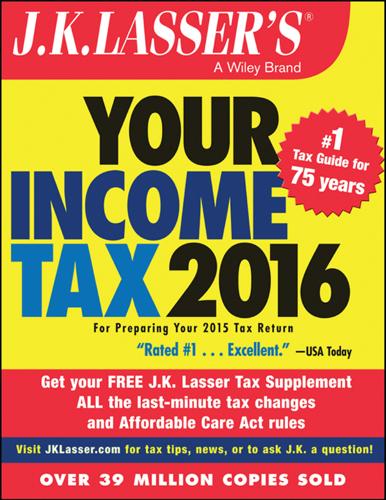
J.K. Lasser's Your Income Tax 2016: For Preparing Your 2015 Tax Return
by
J. K. Lasser Institute
Published 19 Oct 2015
Unemployment benefits from a private or union fund to which you voluntarily contribute dues are taxable as “other” income on Form 1040, but only to the extent the benefits exceed your contributions to the fund. Your contributions to the fund are not deductible. Workers’ compensation payments (2.13) are not taxable. Taxable unemployment benefits include federal trade readjustment allowances (1974 Trade Act), airline deregulation benefits (1978 Airline Deregulation Act), and disaster unemployment assistance (1974 Disaster Relief Act). Repaid supplemental unemployment benefits. If you had to repay supplemental unemployment benefits to receive trade readjustment allowances (1974 Trade Act), taxable unemployment benefits are reduced by repayments made in the same year.
…
See Annual Filing Season Program After-tax retirement contributions, direct rollover of Age 30 duration rule Age 59½ (persons under) Age 65 (persons over) Age 70½ (persons over) Age test Aggregate treatment of activities AGI. See Adjusted gross income Agreements. See specific types Aides (school) Air Force Academy Airline Deregulation Act (1978) Airline pilots Airplanes Aliens. See Nonresident aliens; See Resident aliens Alimony 3rd year recapture for drops in cash payments of child support payments vs. death of payee-spouse and deduction for minimum payment period for payments taxable, as compensation Allowable Credit for 2015 Alternative depreciation system (ADS) Alternative minimum tax (AMT) adjustments and preferences for avoiding depreciation on Form and intangible drilling costs interest on tax-exempt securities and ISOs and kiddie tax and miscellaneous deductions for private activity bonds recovered deductions and state tax refunds and tax credit from regular tax tax credits against and tax rate Alternative trade adjustment assistance (ATAA) program Amended returns Amended U.S.
…
You might be given the right to buy the deceased person’s property under his or her will. This is not the same as inheriting that property. Your basis is what you pay—not what the property is worth on the date of the deceased’s death. If property was inherited from an individual who died after 1976 and before November 7, 1978, and the executor elected to apply a carryover basis to all estate property, your basis is figured with reference to the decedent’s basis. The executor must inform you of the basis of such property. Community property. Upon the death of a spouse in a community property state, one-half of the fair market value of the community property is generally included in the deceased spouse’s estate for estate tax purposes.
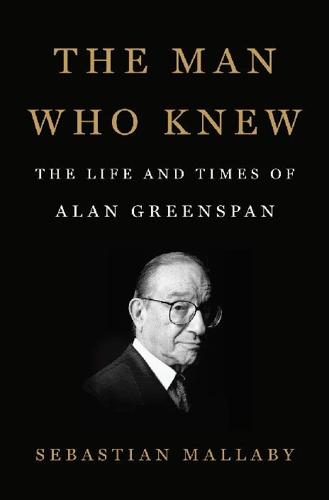
The Man Who Knew: The Life and Times of Alan Greenspan
by
Sebastian Mallaby
Published 10 Oct 2016
Wilson had circulated inside the White House; it argued that the nation’s difficulties arose “not from government’s having neglected the interests of its citizens, but from its having attempted to serve them.”15 The Harris polling organization reported that no more than 13 percent of the public felt confident in government, and most seemed to regard public assistance programs as false friends—the extra taxes they implied would outweigh their benefits.16 Government regulation was losing favor, too. As an outside consultant, Greenspan had tried in vain to push the Nixon administration to embrace deregulation. But by 1975 some Democrats as well as Republicans were coming around to Greenspan’s point of view; in the Senate, it was a Kennedy, of all people, who led hearings that year on airline deregulation. Margaret Thatcher’s firm pronouncements demonstrated that Britain’s economic troubles had generated a libertarian reaction. It seemed possible that the United States might follow. Yet if Britain’s Conservative leader illustrated what might be, there were also darker visions of the future.
…
Christina Romer and David Romer, “Do Tax Cuts Starve the Beast? The Effect of Tax Changes on Government Spending,” Brookings Papers on Economic Activity, Spring 2009, 139–214. 23. “Nation: Economists Eye the Impact,” Time, June 26, 1978. 24. “A Difference of Opinion,” Fortune. 25. Congressional Budget Office, “Understanding Fiscal Policy,” April 1, 1978, 128. 26. Walter Heller, “The Kemp-Roth-Laffer Free Lunch,” Wall Street Journal, July 12, 1978. 27. Greenspan stipulated that “if we continue to have unrestrained expenditure growth on the one hand and sharp cuts in receipts on the other, we will have horrendous deficits.” Then, embracing the Prop 13 faith, he added: “That is clearly true but irrelevant.” 28.
…
“I have here a study by the Joint Economic Committee,” said the chairman, brandishing a report that compared the forecasts of the Greenspan CEA with the economy’s subsequent growth. “[For] the three years 1976, 1977, 1978 the forecasts of the agency which you headed were wrong by the biggest margin of any in the eleven years 1976 to 1986.”47 When it came to forecasting inflation, Proxmire added, Greenspan’s CEA had broken all records for inaccuracy—his prediction for 1978 had been less than half the actual amount. “How do you answer to the facts that your forecasts were so far off?” the senator demanded. After the great financial crisis of 2008, Greenspan’s critics would remember Proxmire’s question as a sort of gotcha occasion—the moment when the maestro mask was torn away, revealing the sallow face of a mundane careerist.48 The senator was attacking the witness at his very core: Greenspan was the man who did not know, Proxmire was insinuating.